Western Digital Technologies SDWS2 Wireless Flash Drive User Manual Wireless Flash Drive UM Android
SanDisk Wireless Flash Drive Wireless Flash Drive UM Android
Contents
- 1. Manual for Android
- 2. Manual for iOS
Manual for Android

USER MANUAL
(For Use with Android™ Mobile Devices)
SanDisk Connect™
Wireless Flash Drive
SanDisk is a trademark of SanDisk Corporation, registered in the United States and other
countries. SanDisk Connect is a trademark of SanDisk Corporation. microSDHC is a trademark
of SD-3C, LLC. Android is a trademark of Google Inc. Wi-Fi is a registered trademark of the Wi-Fi
Alliance. All other trademarks are the property of their respective owners.
©2013 SanDisk Corporation. All rights reserved.

SanDisk Connect™ Wireless Flash Drive User Manual for Android i
Contents
1. Introduction . . . . . . . . . . . . . . . . . . . . . . . . . . . . . . . . . . . . . . . 1
Wireless Flash Drive Overview . . . . . . . . . . . . . . . . . . . . . . . . . . . . . . 1
Features . . . . . . . . . . . . . . . . . . . . . . . . . . . . . . . . . . . . . . . . . . . . . . . 1
System Requirements . . . . . . . . . . . . . . . . . . . . . . . . . . . . . . . . . . . . .1
Supported File Formats . . . . . . . . . . . . . . . . . . . . . . . . . . . . . . . . . . . 2
Hardware Specifications . . . . . . . . . . . . . . . . . . . . . . . . . . . . . . . . . . .2
2. Getting Started . . . . . . . . . . . . . . . . . . . . . . . . . . . . . . . . . . . . . 3
Charging the Wireless Drive . . . . . . . . . . . . . . . . . . . . . . . . . . . . . . . . 3
Wireless Drive LEDs . . . . . . . . . . . . . . . . . . . . . . . . . . . . . . . . . . . . . .4
Downloading the SanDisk Wireless Flash Drive App . . . . . . . . . . . . .4
Connecting to the Wireless Drive . . . . . . . . . . . . . . . . . . . . . . . . . . . . 4
Connecting via Wi-Fi . . . . . . . . . . . . . . . . . . . . . . . . . . . . . . . . . . .4
Accessing the Drive without an App . . . . . . . . . . . . . . . . . . . . . . . .7
Loading Content on the Wireless Drive . . . . . . . . . . . . . . . . . . . . . . . .8
From a PC . . . . . . . . . . . . . . . . . . . . . . . . . . . . . . . . . . . . . . . . . . . 9
From a Mobile Device . . . . . . . . . . . . . . . . . . . . . . . . . . . . . . . . . . .9
3. Working with Files . . . . . . . . . . . . . . . . . . . . . . . . . . . . . . . . . 12
Wireless Drive Application Overview . . . . . . . . . . . . . . . . . . . . . . . . 12
Wireless Drive Start Screen . . . . . . . . . . . . . . . . . . . . . . . . . . . . .12
Wireless Drive Main Screen . . . . . . . . . . . . . . . . . . . . . . . . . . . . .13
Using the Wireless Drive App Menu . . . . . . . . . . . . . . . . . . . . . . . . . 14
Wireless Drive App Menu Options . . . . . . . . . . . . . . . . . . . . 15
Using the Wireless Drive File Menu 1 . . . . . . . . . . . . . . . . . . . . . . .5
Wireless Drive File Menu Options . . . . . . . . . . . . . . . . . . . . . 15
Accessing Files through the Wireless Drive App . . . . . . . . . . . . . . . .15
Toggling between List View and Grid View . . . . . . . . . . . . . . . . . . . .16

SanDisk Connect™ Wireless Flash Drive User Manual for Android ii
Viewing Photos . . . . . . . . . . . . . . . . . . . . . . . . . . . . . . . . . . . . . . . . .17
Streaming Videos . . . . . . . . . . . . . . . . . . . . . . . . . . . . . . . . . . . . . . . .18
Playing Music . . . . . . . . . . . . . . . . . . . . . . . . . . . . . . . . . . . . . . . . . . .20
Playing Music in the Background While Outside the App . . . . . . 20
Moving Files . . . . . . . . . . . . . . . . . . . . . . . . . . . . . . . . . . . . . . . . . . . .21
Downloading Files . . . . . . . . . . . . . . . . . . . . . . . . . . . . . . . . . . . .21
Uploading Files . . . . . . . . . . . . . . . . . . . . . . . . . . . . . . . . . . . . . . .23
Creating a New Folder . . . . . . . . . . . . . . . . . . . . . . . . . . . . . 23
Uploading Files from the Phone Gallery or Downloads Folder 24
Uploading Files from Other Locations on the Mobile Device 26
Sharing Files . . . . . . . . . . . . . . . . . . . . . . . . . . . . . . . . . . . . . . . . .27
Allowing Access to your Wireless Drive . . . . . . . . . . . . . . . . 27
Sending Files to Others . . . . . . . . . . . . . . . . . . . . . . . . . . . . . 27
Deleting Files . . . . . . . . . . . . . . . . . . . . . . . . . . . . . . . . . . . . . . . . . . 28
Deleting a File . . . . . . . . . . . . . . . . . . . . . . . . . . . . . . . . . . . . . . . .29
Deleting a Folder . . . . . . . . . . . . . . . . . . . . . . . . . . . . . . . . . . . . .30
Unsupported File Formats . . . . . . . . . . . . . . . . . . . . . . . . . . . . . . . . 31
4. Managing the Wireless Drive . . . . . . . . . . . . . . . . . . . . . . . . . 32
Updating the Firmware . . . . . . . . . . . . . . . . . . . . . . . . . . . . . . . . . . . .32
Updating the App . . . . . . . . . . . . . . . . . . . . . . . . . . . . . . . . . . . . . . . .34
Managing Wireless Drive Settings . . . . . . . . . . . . . . . . . . . . . . . . . . .34
Saving Settings Changes . . . . . . . . . . . . . . . . . . . . . . . . . . . . . . 35
Changing the Wireless Drive Network Name . . . . . . . . . . . . . . . .37
Creating/Changing a Password . . . . . . . . . . . . . . . . . . . . . . . . . .38
Restoring Factory Settings . . . . . . . . . . . . . . . . . . . . . . . . . . . . . .40
Setting the Power Save Timer . . . . . . . . . . . . . . . . . . . . . . . . . . .40
Connecting to the Internet . . . . . . . . . . . . . . . . . . . . . . . . . . . . . . 41
Adding a Preferred Network . . . . . . . . . . . . . . . . . . . . . . . . . 43
Setting the Downloads Directory . . . . . . . . . . . . . . . . . . . . . . . . .46
Resetting Messages and Warnings . . . . . . . . . . . . . . . . . . . . . . .47

SanDisk Connect™ Wireless Flash Drive User Manual for Android iii
Getting Support . . . . . . . . . . . . . . . . . . . . . . . . . . . . . . . . . . . . . . 49
Quick Start Guide . . . . . . . . . . . . . . . . . . . . . . . . . . . . . . . . . 49
About . . . . . . . . . . . . . . . . . . . . . . . . . . . . . . . . . . . . . . . . . . . 50
5. Product and Safety Information . . . . . . . . . . . . . . . . . . . . . . . 51
Product Specifications . . . . . . . . . . . . . . . . . . . . . . . . . . . . . . . . . . . .51
Regulatory Information . . . . . . . . . . . . . . . . . . . . . . . . . . . . . . . . . . . .51
Safety and Care . . . . . . . . . . . . . . . . . . . . . . . . . . . . . . . . . . . . . . . . .53
Cleaning . . . . . . . . . . . . . . . . . . . . . . . . . . . . . . . . . . . . . . . . . . . . . . .54
Maintenance and Storage . . . . . . . . . . . . . . . . . . . . . . . . . . . . . . . . .54
Standard Maintenance . . . . . . . . . . . . . . . . . . . . . . . . . . . . . . . . 54
Long Term Storage . . . . . . . . . . . . . . . . . . . . . . . . . . . . . . . . . . . .55
Recycling . . . . . . . . . . . . . . . . . . . . . . . . . . . . . . . . . . . . . . . . . . .55
Index . . . . . . . . . . . . . . . . . . . . . . . . . . . . . . . . . . . . . . . . . . . 56

1. Introduction Wireless Flash Drive Overview
SanDisk Connect™ Wireless Flash Drive User Manual for Android 1
1. Introduction
Wireless Flash Drive Overview
The SanDisk Connect™ Wireless Flash Drive stores, shares, and streams digital
content wirelessly across multiple mobile devices.
Features
•Share files with others. The Wireless Drive creates its own wireless network. Up
to eight mobile devices can be wirelessly connected and access files on the Drive
at the same time.
•Stay connected to the Internet while accessing content from the Wireless
Drive. In areas where Internet Wi-Fi access is available, you can stream content
from the Wireless Drive and keep your mobile device connected to the Internet at
the same time.
•Use the Wireless Drive for extra storage. Up to 32 GB of space can be used to
store digital content from a mobile device.
System Requirements
• Mobile phones or tablets running iOS version 5.0 or higher, Android version 2.3 or
higher, or other Wi-Fi-enabled devices with a web browser

1. Introduction Supported File Formats
SanDisk Connect™ Wireless Flash Drive User Manual for Android 2
• Computers running Windows® 8, Windows 7, Windows Vista®, Windows XP or
Mac OS 10.6 or higher
Supported File Formats
• Any file formats supported by your mobile device
• For additional information about supported formats, go to www.sandisk.com/
support
Hardware Specifications
• Drive Capacity: 16 GB or 32 GB1
• USB: 2.0 compatible
• Battery: Non-user replaceable lithium-ion battery
• Battery Life: Up to 4 hours of continuous streaming and standby2
• Maximum Wi-Fi range: 160 feet (50 meters)
• Wireless Drive Memory Card Format: FAT32
11GB=1,000,000,000 bytes. Actual user storage less.
2Based on streaming 720p content at 2mbps to one device; actual life and performance may vary
depending upon usage and settings; battery not replaceable.

2. Getting Started Charging the Wireless Drive
SanDisk Connect™ Wireless Flash Drive User Manual for Android 3
2. Getting Started
Charging the Wireless Drive
Although the Wireless Drive is shipped with a charged battery, we urge you to fully
charge the Drive before you begin to use it. (This can take up to two hours.)
• Plug your Wireless Drive into a computer USB port or a USB AC adaptor to
charge it:
Note: Although the Wireless Drive cannot be used wirelessly while it’s plugged into a
computer USB port, it can be used as a normal flash drive. However, the Drive can be
used wirelessly while it’s charging in a USB AC adaptor. If you want to use the Drive
while it’s plugged into an adaptor, be sure to turn it on before you plug it in.

2. Getting Started Wireless Drive LEDs
SanDisk Connect™ Wireless Flash Drive User Manual for Android 4
Wireless Drive LEDs
Downloading the SanDisk Wireless Flash Drive App
1. Download the free SanDisk Wireless Flash Drive app from
your mobile device application store onto each mobile device
you want to use with the Drive.
2. Find the app icon on the mobile device and tap it to open the app.
Connecting to the Wireless Drive
You can connect to the Wireless Drive Wi-Fi network on your mobile device in two
ways:
• You can download the Wireless Flash Drive app and connect to the Drive via Wi-
Fi.
• You can access the Drive without installing the Wireless Drive app via a web
browser.
Connecting via Wi-Fi
After you launch the app, your mobile device automatically discovers the Wireless
Drive Wi-Fi network.
To connect to the Wireless Drive,
Mode LEDs Activity
Wi-Fi on Blue Flashes
Turn Wi-Fi on and off Blue and Amber Flash three times
Wi-Fi data transfer in
progress
Blue Flashes rapidly
USB data transfer in
progress
Amber Flashes rapidly
Battery charging Amber Shines steadily
Battery fully charged Amber Off
Battery strength 5-10%
(Wi-Fi is on)
Amber Repeatedly flashes
three times
Factory Reset Blue and Amber Flash rapidly after Wi-Fi
button has been held in
for 30 seconds (does
NOT delete files stored
on the Drive)
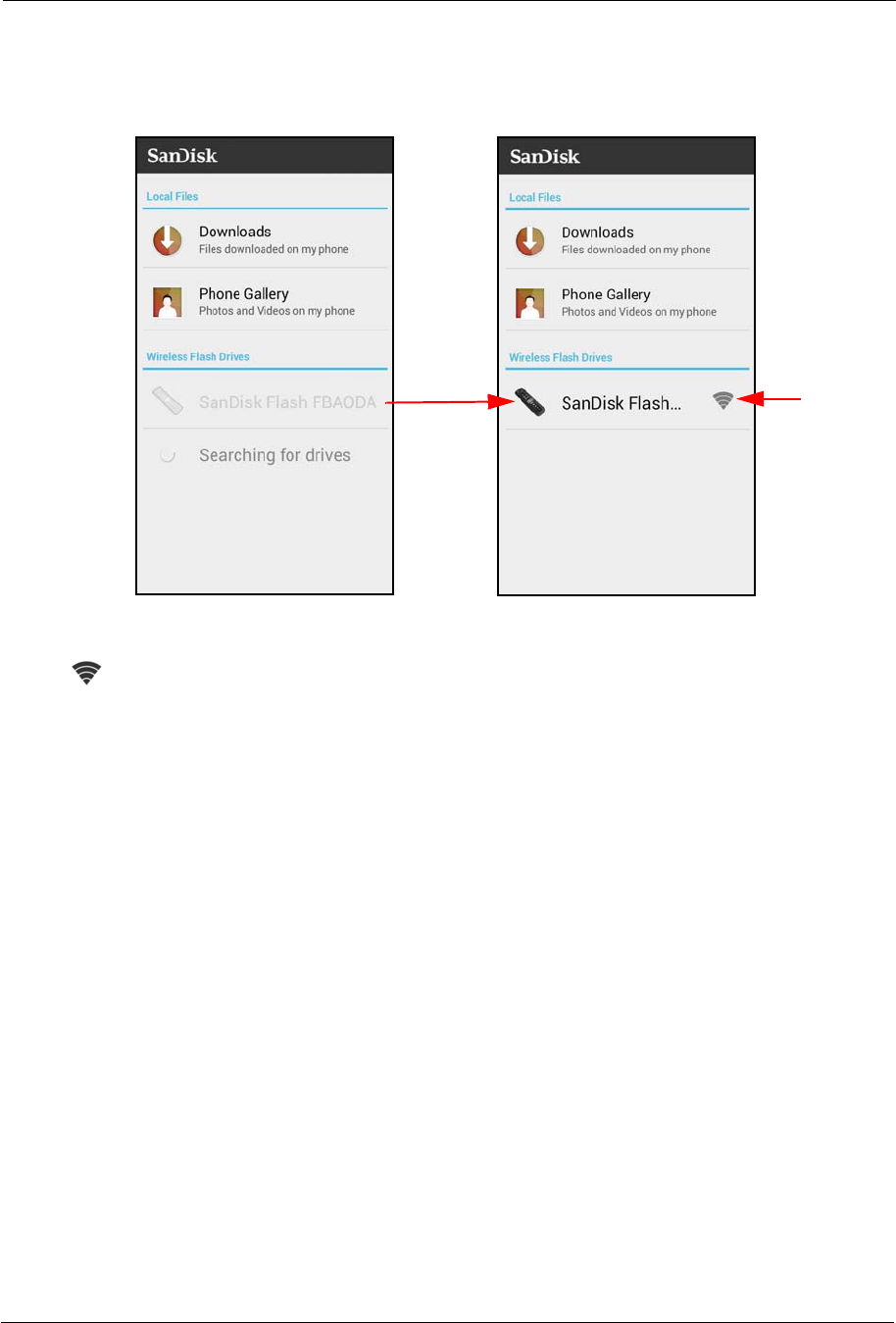
2. Getting Started Connecting to the Wireless Drive
SanDisk Connect™ Wireless Flash Drive User Manual for Android 5
1. Tap the Wireless Flash Drive app icon on your mobile device to open the Wireless
Drive start screen:
Your mobile device searches for your Wireless Drive Wi-Fi network. The Wi-Fi icon
indicates that your Wireless Drive Wi-Fi has been detected.
2. When your Drive name appears below Wireless Flash Drives, tap it to connect to
the Drive.
Wi-Fi
detected
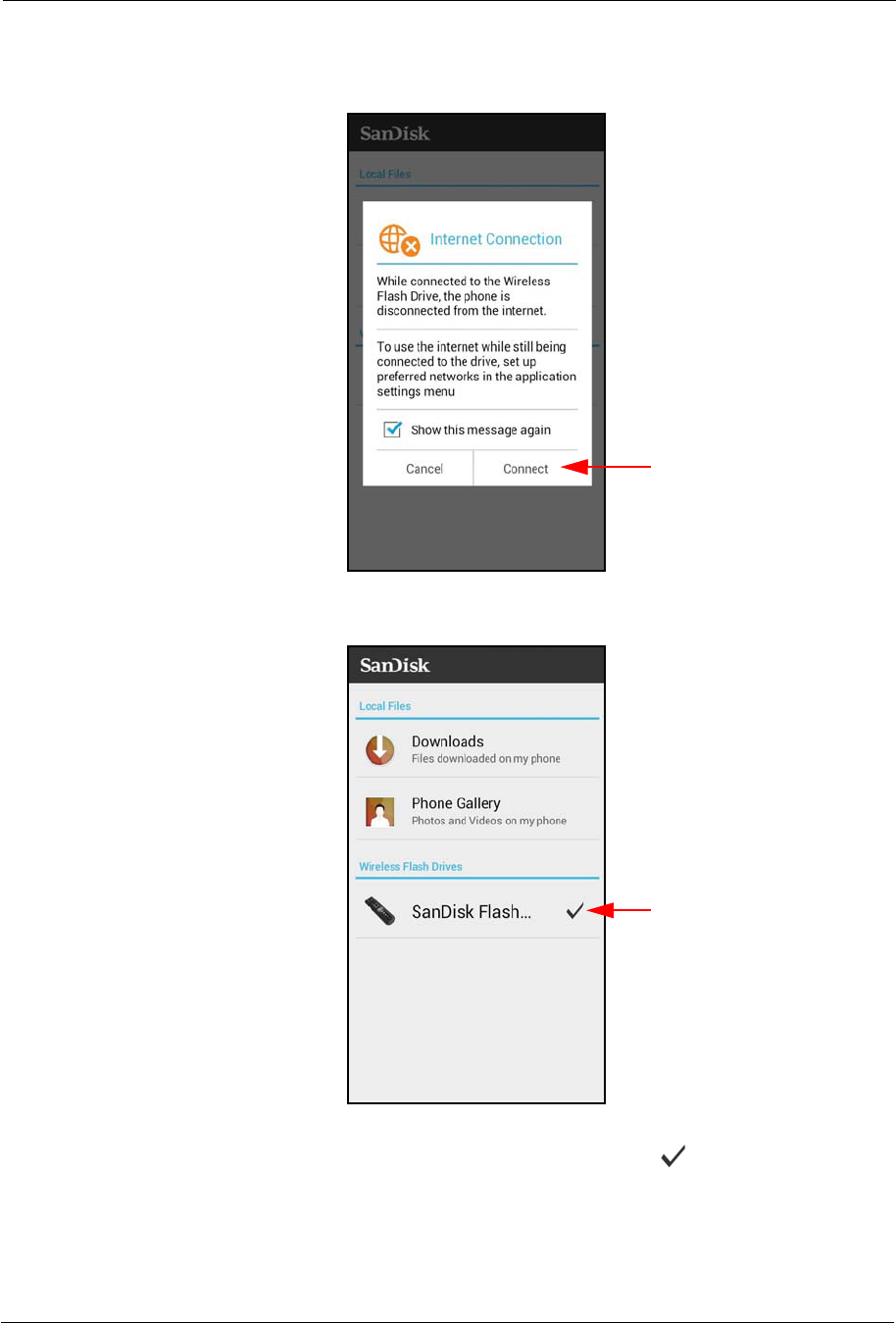
2. Getting Started Connecting to the Wireless Drive
SanDisk Connect™ Wireless Flash Drive User Manual for Android 6
An Internet Connection window opens:
3. Tap Connect to connect your mobile device to the Drive:
You return to the start screen, where the Connection icon indicates that your
mobile device is now directly connected to the Wireless Drive.
4. Below Wireless Flash Drives, tap your Drive name.
The connection window provides
information about how to remain
connected to the Internet while
using your Drive by setting up a
Preferred Network.
After you’ve read and understood
the information provided here,
you can choose not to see this
message again. You can connect
directly to your Drive without using
You can always get this message
to show again by selecting Reset
this screen.
Messages and Warnings in
Settings.
Drive
connected

2. Getting Started Connecting to the Wireless Drive
SanDisk Connect™ Wireless Flash Drive User Manual for Android 7
You see the Wireless Drive main screen:
Note: For information about enabling Internet access while using your Drive, see Chapter 4,
Managing Your Drive.
Accessing the Drive without an App
You can connect to the Wireless Drive Wi-Fi network on your mobile device, PC, or
Mac without downloading the Wireless Flash Drive app by using a web browser to
access the Drive.
1. In your mobile device Wi-Fi settings, connect to the Wireless Drive Wi-Fi network.
It appears in the list of available networks as SanDisk Flashxxxxxx (for example,
SanDisk Flash123456).
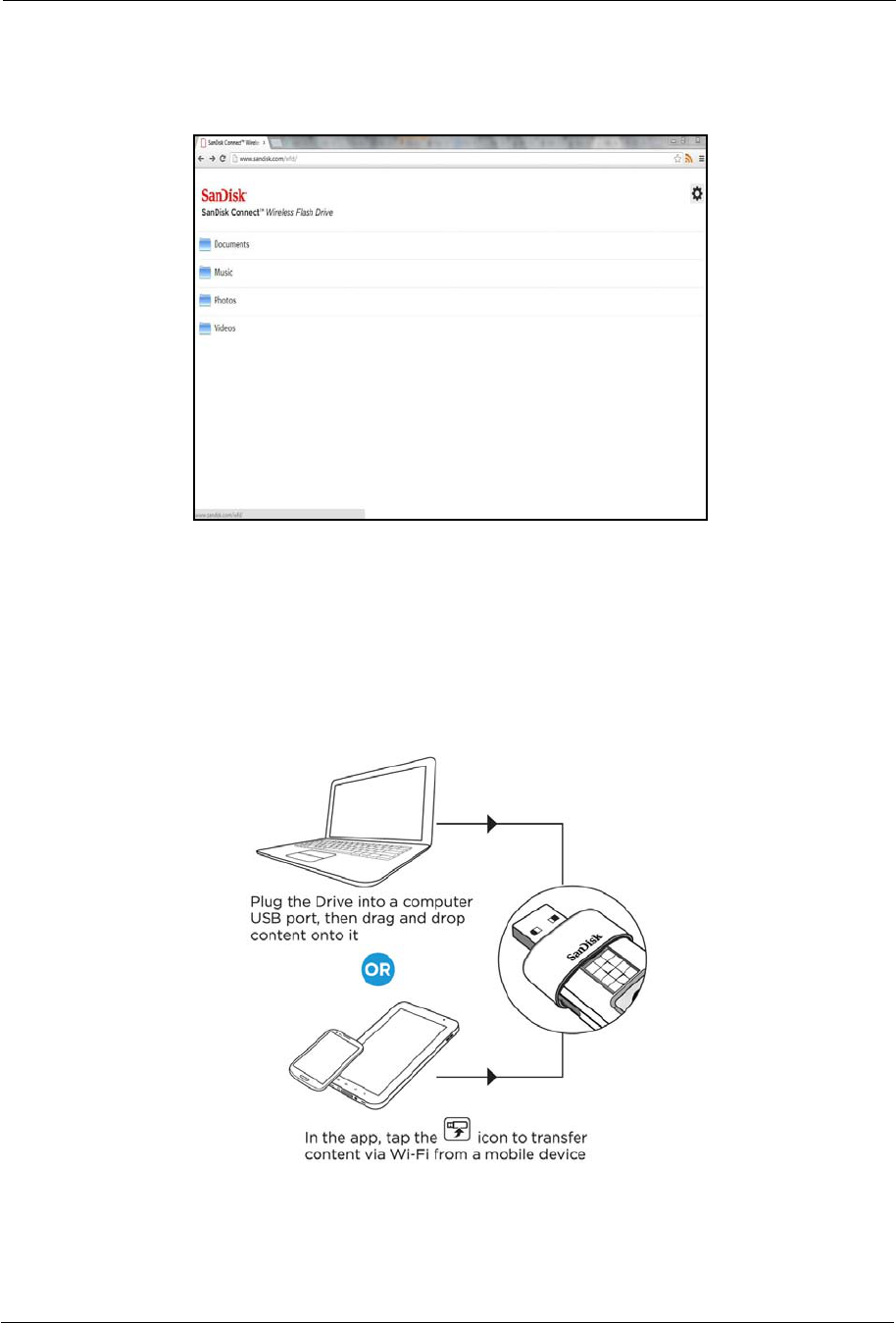
2. Getting Started Loading Content on the Wireless Drive
SanDisk Connect™ Wireless Flash Drive User Manual for Android 8
2. Launch an Internet browser and go to www.sandisk.com/wfd to connect to the
Wireless Drive:
Loading Content on the Wireless Drive
You can load content in two ways:
• Plug your Wireless Drive into your computer, then drag and drop content onto it.
• Transfer content via Wi-Fi from a mobile device to your Wireless Drive.
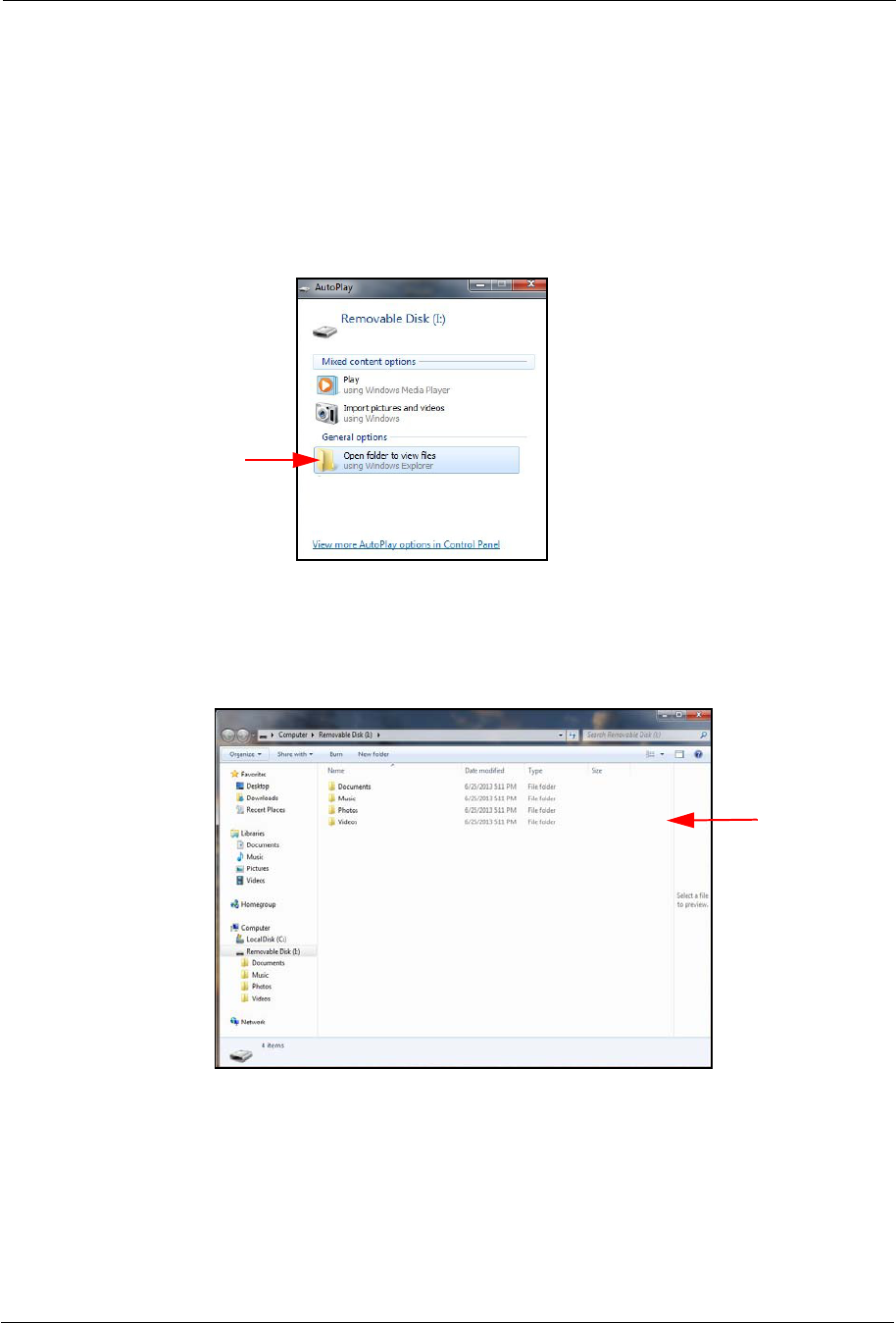
2. Getting Started Loading Content on the Wireless Drive
SanDisk Connect™ Wireless Flash Drive User Manual for Android 9
From a PC
You can transfer content between your Wireless Drive and your PC using a USB
connection.
1. Plug your Wireless Drive into your computer USB port.
2. In the AutoPlay window, click Open folder to view files:
3. Drag and drop music, videos, photos, and documents from your computer into the
Wireless Drive window. You can drop your files anywhere on the Wireless Drive
or you can create folders and add content to them; for example, the Music,
Photos,Videos, and Documents folders in the window below:
You can also drag content from the Wireless Drive window onto your computer to
move files between your mobile devices and your computer.
From a Mobile Device
You can upload files and folders stored on your mobile device to the Wireless Drive.

2. Getting Started Loading Content on the Wireless Drive
SanDisk Connect™ Wireless Flash Drive User Manual for Android 10
To upload files, photos, or videos from the Phone Gallery,
1. On the Wireless Drive start screen, tap Downloads or Phone Gallery to navigate
to the files you want to upload:
2. On the screen displaying the files to be uploaded, tap the Upload icon and
select the desired files (the selected files are outlined in blue). Then again tap the
Upload icon, which is now green :
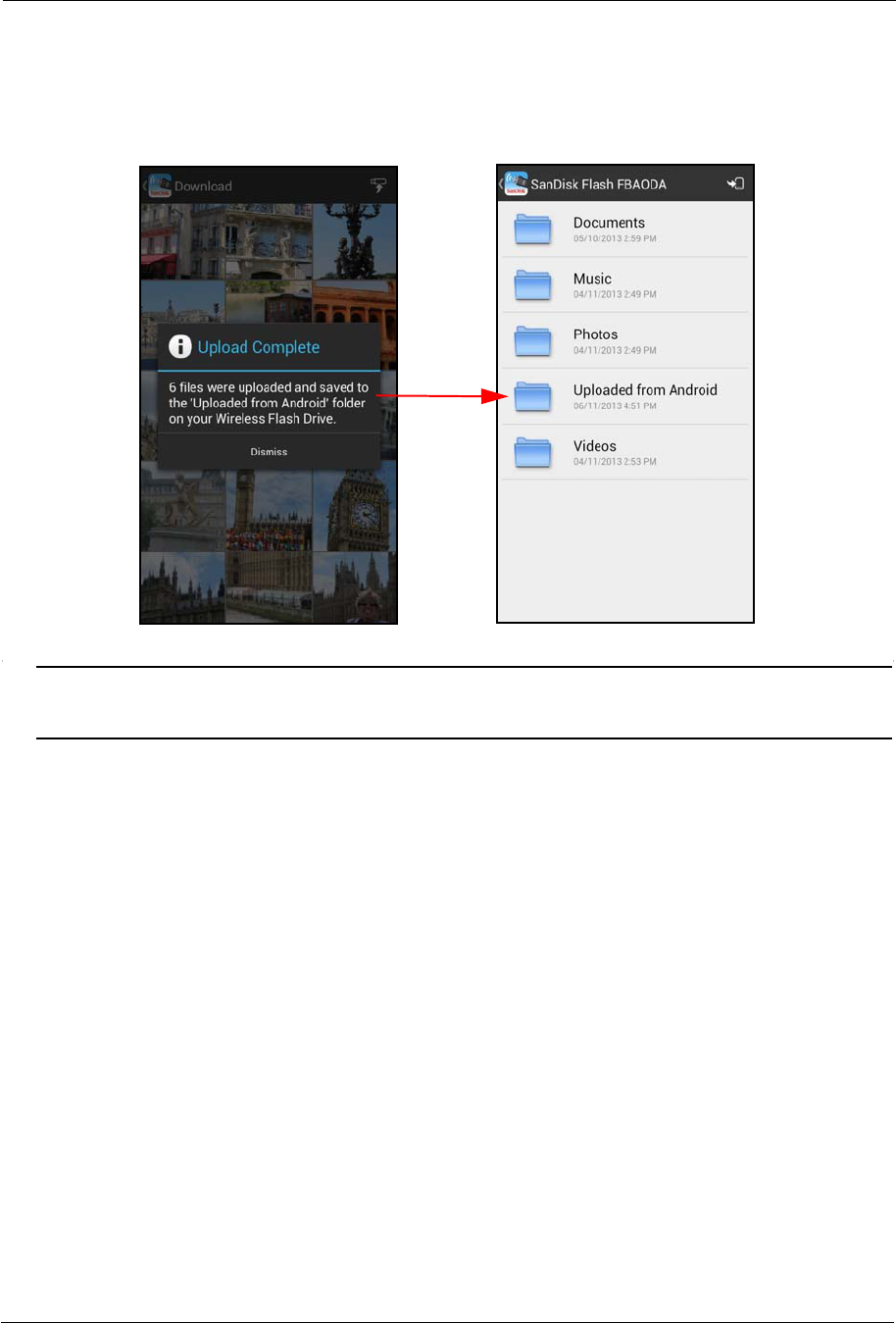
2. Getting Started Loading Content on the Wireless Drive
SanDisk Connect™ Wireless Flash Drive User Manual for Android 11
3. An Upload Complete window confirms a successful upload and informs you that
the uploaded files can be found in the Uploaded from Android folder on your
Drive:
Note: For more detailed information on using photo, music, and video files, see Chapter 3,
Working with Files.

3. Working with Files Wireless Drive Application Overview
SanDisk Connect™ Wireless Flash Drive User Manual for Android 12
3. Working with Files
Wireless Drive Application Overview
The Wireless Drive app start screen provides access to files stored on both your
Wireless Flash Drive and your mobile device. It also contains a Help link.
Wireless Drive Start Screen
Files downloaded
from Drive
Files stored
on mobile
device
Help link
Settings link
Wi-Fi
detected
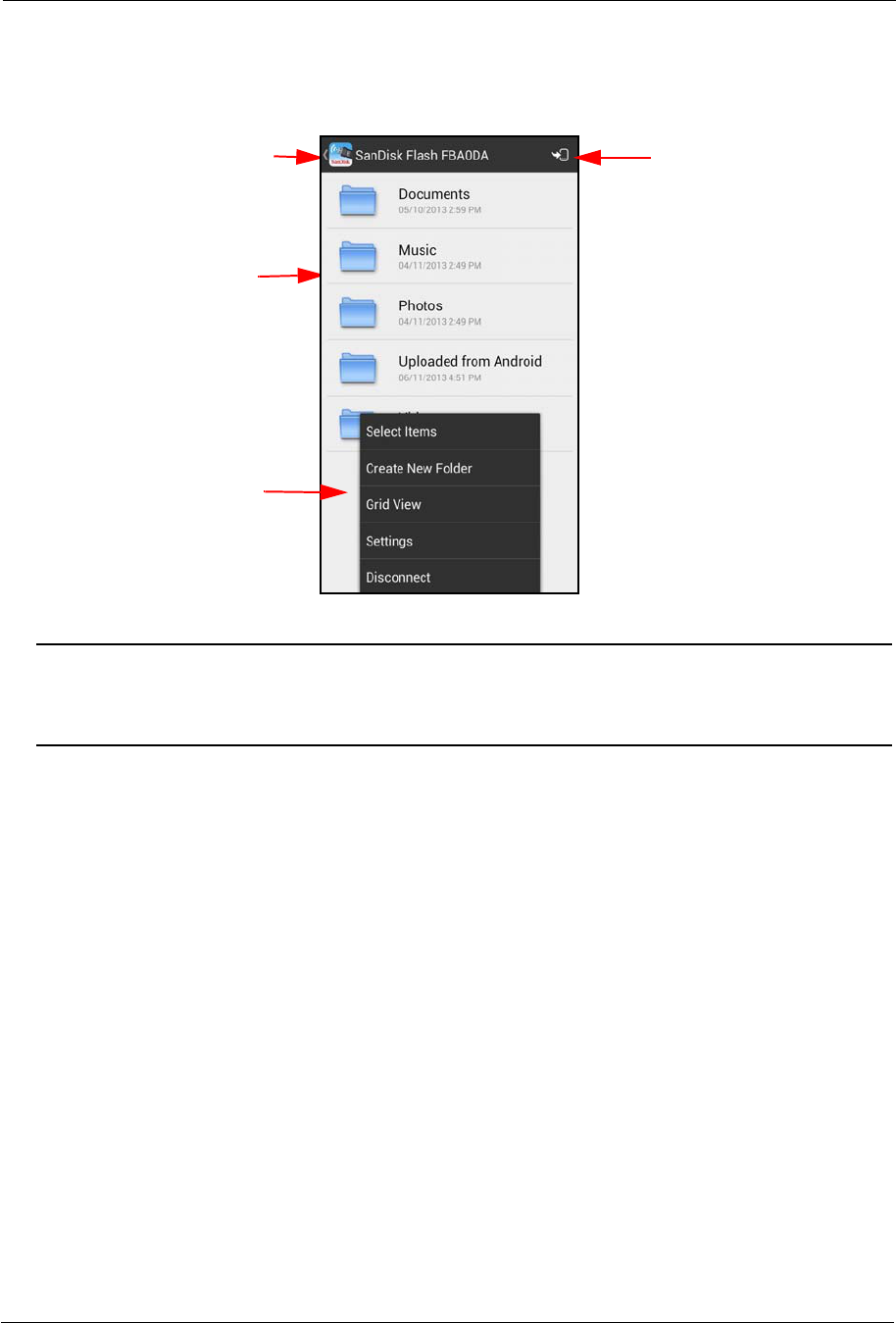
3. Working with Files Wireless Drive Application Overview
SanDisk Connect™ Wireless Flash Drive User Manual for Android 13
Wireless Drive Main Screen
Note: The folders shown in these images illustrate just one of the ways you can choose to
organize and display the photo, video, music, and document files stored on your
Wireless Drive.
App
menu
Files
stored
on Drive
Location Bar Download
icon
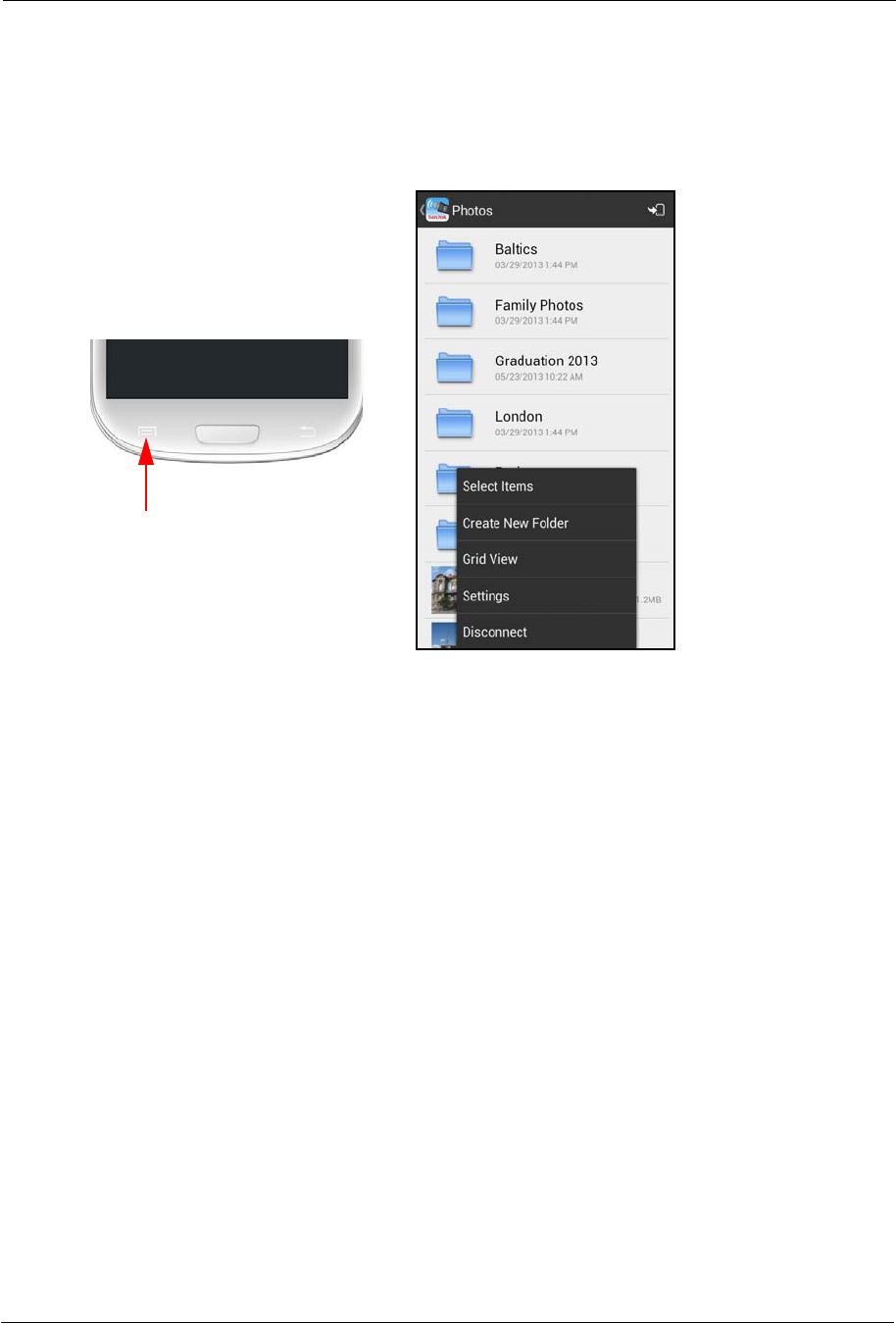
3. Working with Files Using the Wireless Drive App Menu
SanDisk Connect™ Wireless Flash Drive User Manual for Android 14
Using the Wireless Drive App Menu
You can tap your mobile device Menu button to display the Wireless Drive app menu
from anywhere in the app except on a video, music, and photo Play screen:
Menu
button
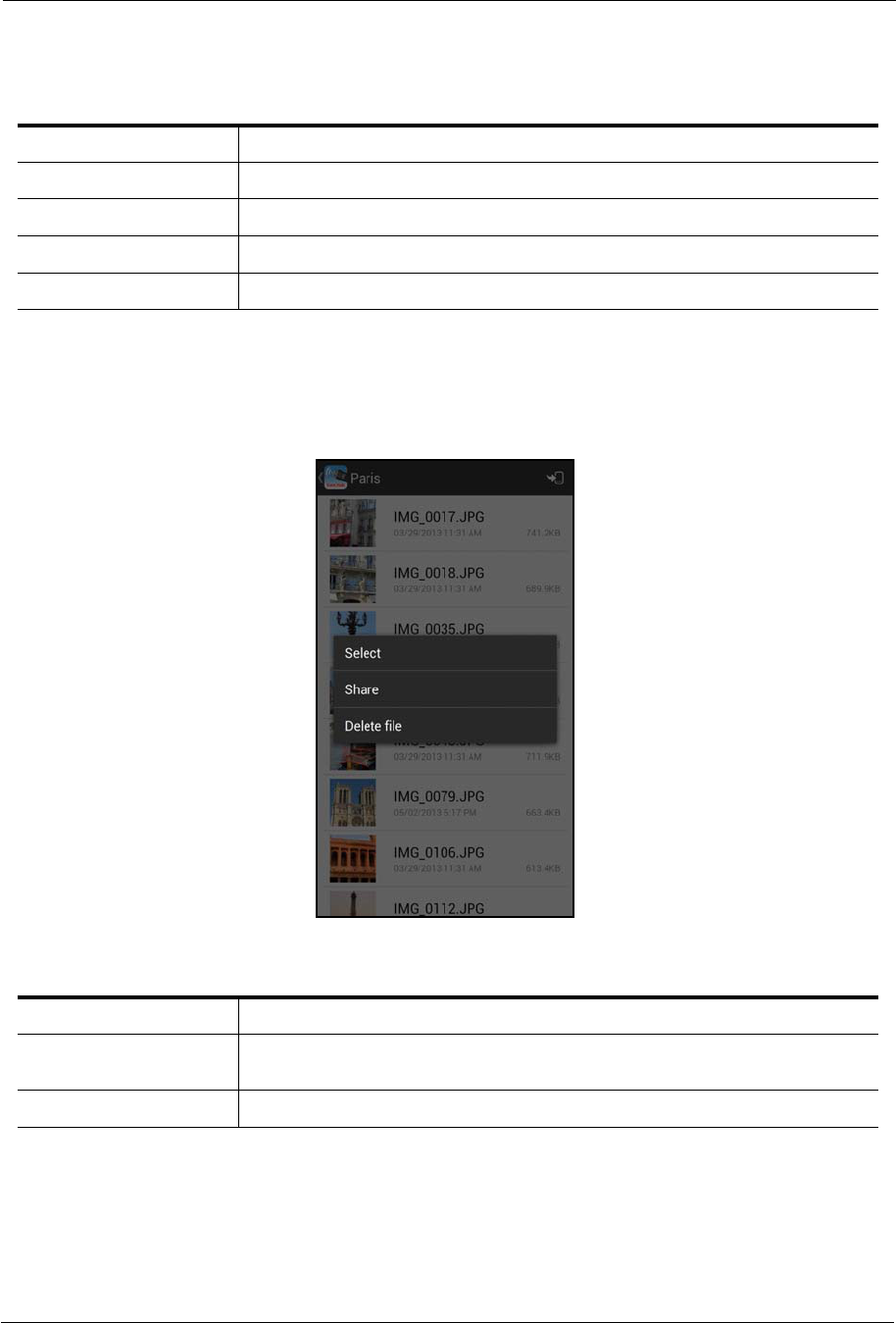
3. Working with Files Accessing Files through the Wireless Drive App
SanDisk Connect™ Wireless Flash Drive User Manual for Android 15
Wireless Drive App Menu Options
Using the Wireless Drive File Menu
You can long press on a file (but not on a folder) to display the Wireless Drive file
menu from any screen that displays files:
Wireless Drive File Menu Options
Accessing Files through the Wireless Drive App
You can use the Wireless Drive app to access videos, music, photos, and documents
stored on the Drive or in the Downloads or Gallery folders on your mobile device.
Select Items Identify files to be uploaded, downloaded, shared, or deleted
Create New Folder Add a new folder to the list of files and folders currently displayed on the screen
Grid View/List View Toggle between viewing files and folders as a list and viewing them in a grid
Settings Open the Wireless Drive Settings screen
Disconnect Disconnect from the Wireless Drive
Select Quickly select a file to download or delete it (additional files can be selected)
Share Send a file to others via email, social media, messaging, or Bluetooth (available
methods vary depending upon the features provided on your mobile device)
Delete file Delete a single file

3. Working with Files Toggling between List View and Grid View
SanDisk Connect™ Wireless Flash Drive User Manual for Android 16
1. On the Wireless Drive start screen, tap the location of the desired content:
2. Navigate to the desired file and tap it to open it in the Wireless Drive app.
Toggling between List View and Grid View
You can view the files and folders on any Wireless Drive app screen in either list view
or grid view.
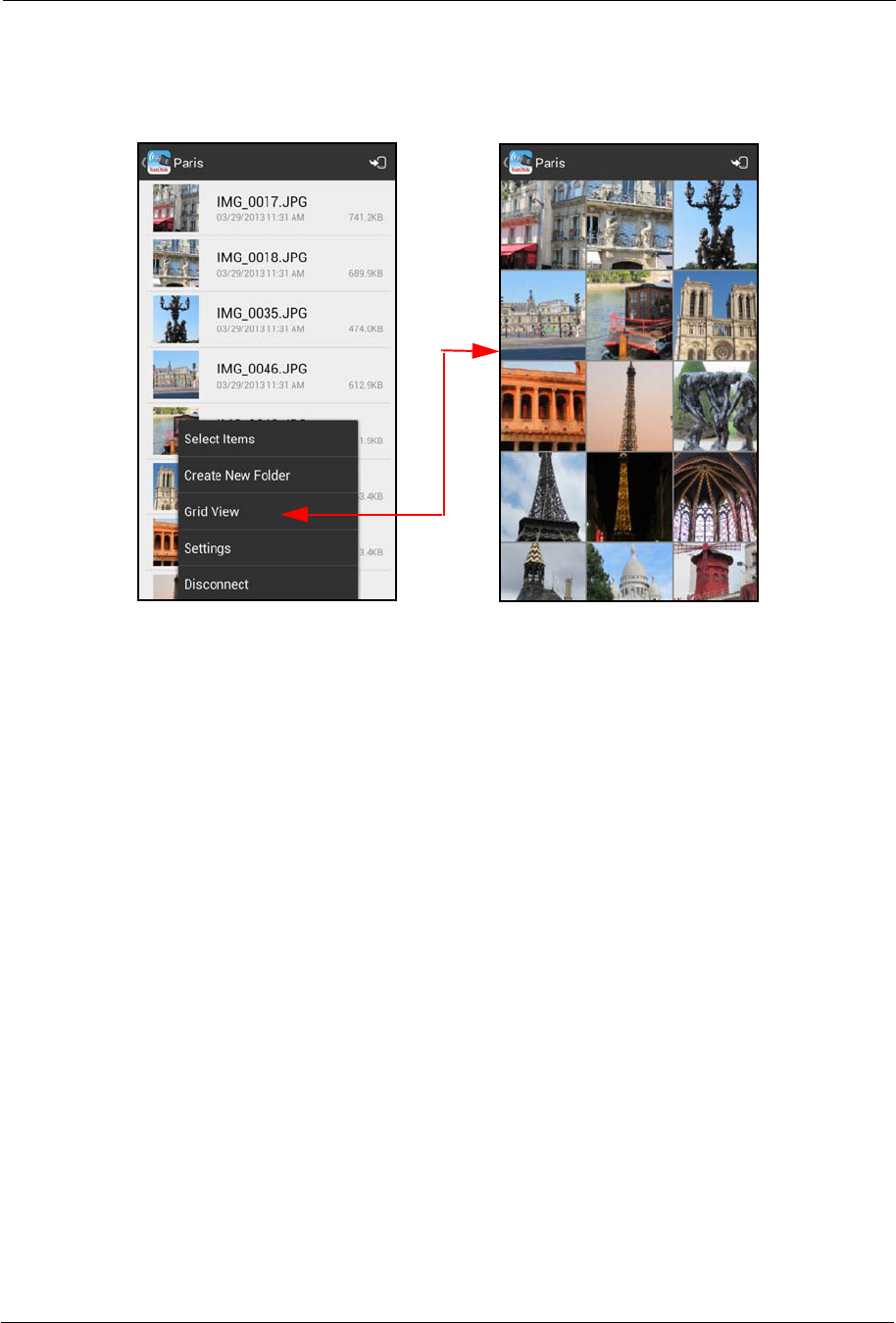
3. Working with Files Viewing Photos
SanDisk Connect™ Wireless Flash Drive User Manual for Android 17
• Tap the mobile device Menu button to display the Wireless Drive app menu and
toggle between a list view and a grid view of your content:
Viewing Photos
You can use the Wireless Drive app to view photos stored on the Drive or in the
Downloads or Gallery folders on your mobile device.
1. Navigate to the photos you want to view.

3. Working with Files Streaming Videos
SanDisk Connect™ Wireless Flash Drive User Manual for Android 18
2. Tap a photo to display a full-screen image:
3. Tap the photo to display the photo controls:
Streaming Videos
You can use the Wireless Drive app to stream videos stored on the Drive or in the
Downloads or Gallery folders on your mobile device.
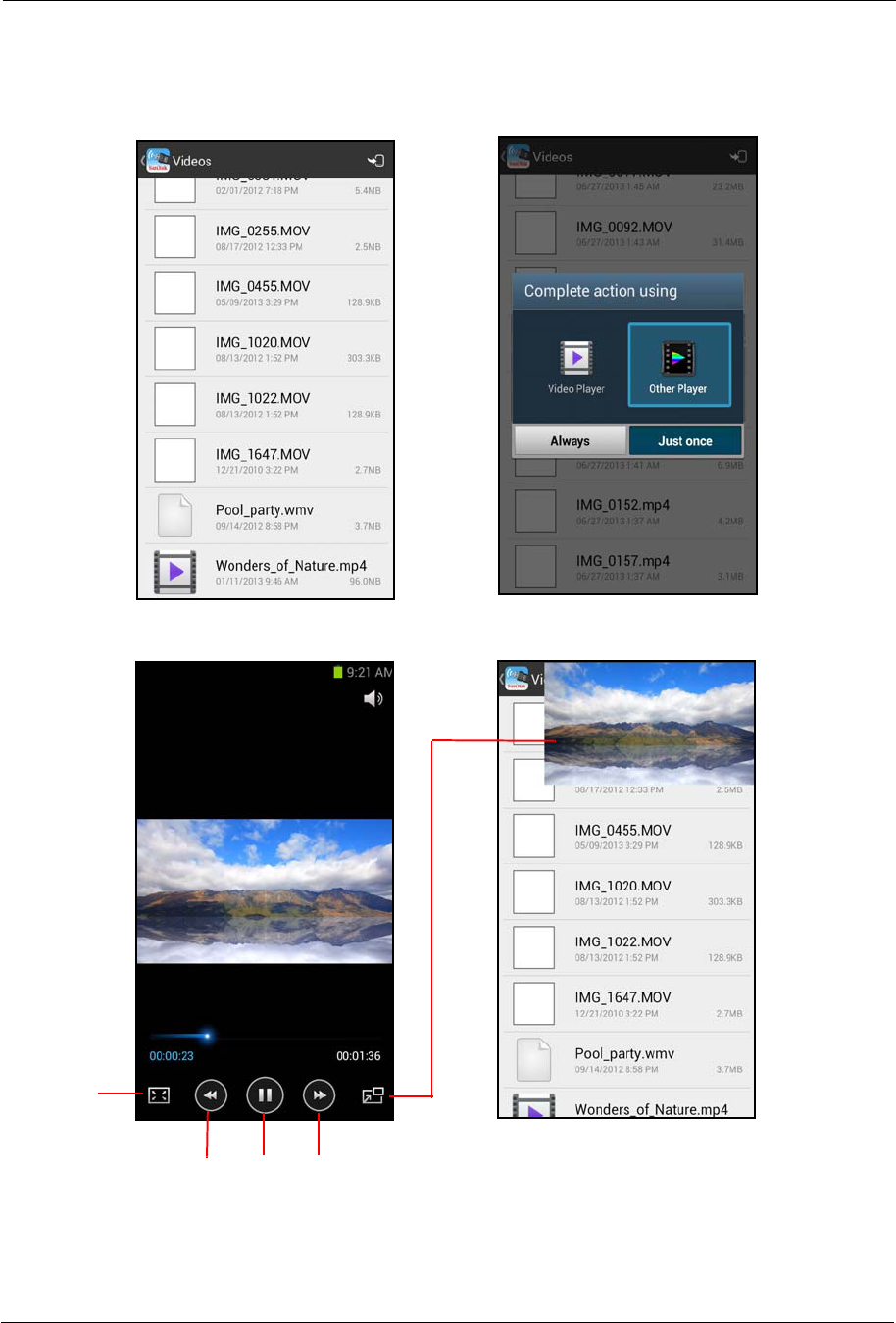
3. Working with Files Streaming Videos
SanDisk Connect™ Wireless Flash Drive User Manual for Android 19
1. Navigate to the video you want to stream, tap on it, and select a video player with
which to stream it:
2. As the video starts to play, tap on it to display the video play controls:
Full
screen
Reverse Play/ Fast
Pause Forward
Picture-in-
Picture

3. Working with Files Playing Music
SanDisk Connect™ Wireless Flash Drive User Manual for Android 20
If you tap Picture-in-Picture, the video continues to stream in a small window when
you leave the video Play screen and move around in the Wireless Drive app or exit
the app and use your mobile device.
3. Tap the video window to return to the video Play screen and stop the video or
watch it on the full screen.
Playing Music
You can use the Wireless Drive app to play music stored on your Wireless Drive or in
the Downloads or Gallery folders on your mobile device.
1. Navigate to the music you want to play.
2. Tap a song to start playing it:
Playing Music in the Background While Outside the App
You can play the music in the background while you exit the app and use your mobile
device for other things. You always have access to the currently playing song.
1. Start the music playing.
2. Tap the Home button on your mobile device.
You are taken away from the music Play screen and out of the Wireless Drive app
to your mobile device desktop.
Song
paused:
Tap to
play
Tap to
pause
Song
playing:
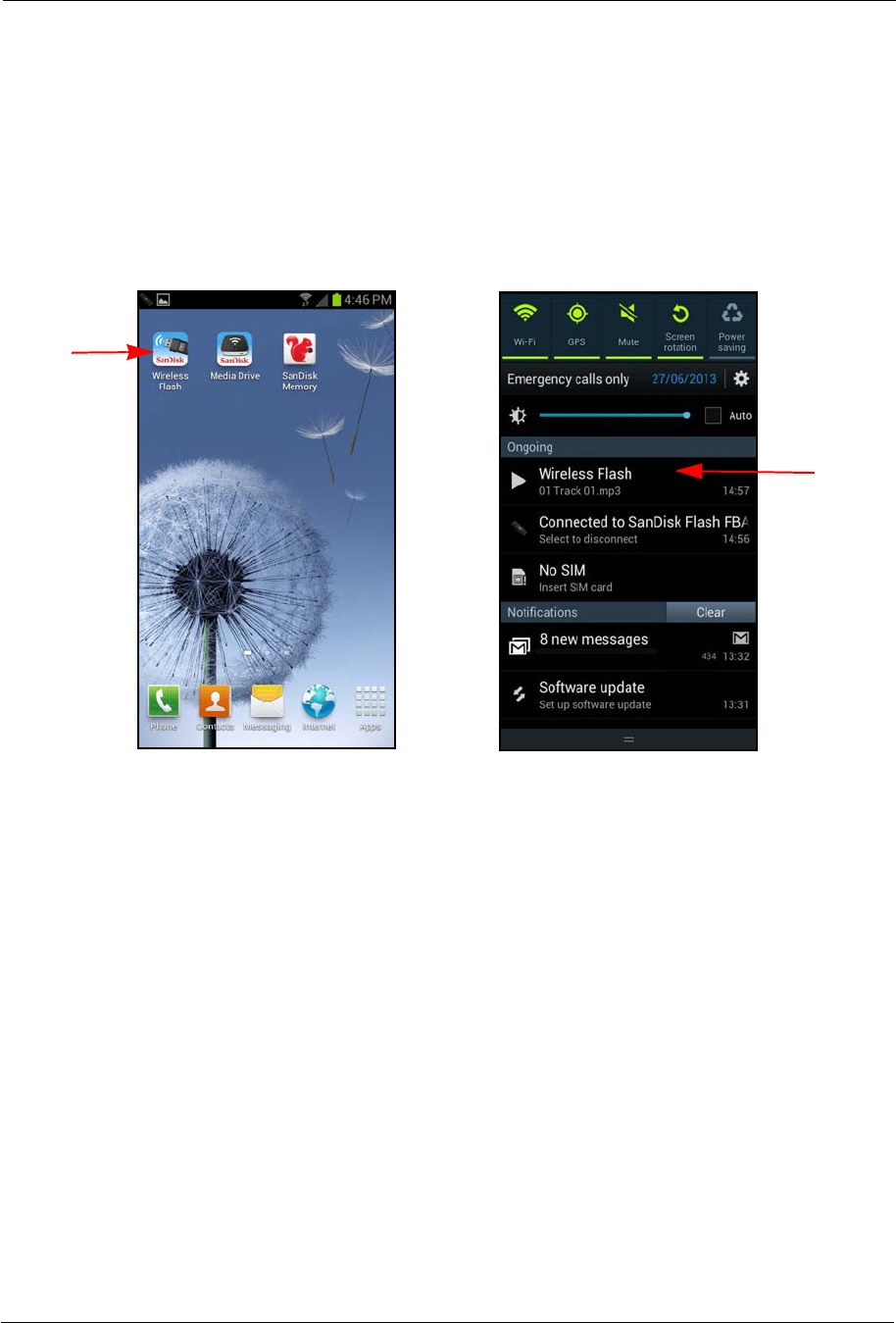
3. Working with Files Moving Files
SanDisk Connect™ Wireless Flash Drive User Manual for Android 21
3. You can return to the music Play screen and change or stop the music playing in
the background in either of two ways:
• Tap the Wireless Flash Drive icon on your mobile device Apps screen.
— OR —
• Pull down the Android notification drawer and tap the Wireless Flash entry
under Ongoing:
You’re returned to the music Play screen in the Wireless Drive app.
Moving Files
Files can be moved in three ways:
• Download files from your Wireless Drive to a mobile device.
• Upload files to your Wireless Drive from a mobile device.
• Share files with others directly from the Wireless Drive mobile app.
Downloading Files
To download files from your Wireless Drive to a mobile device,
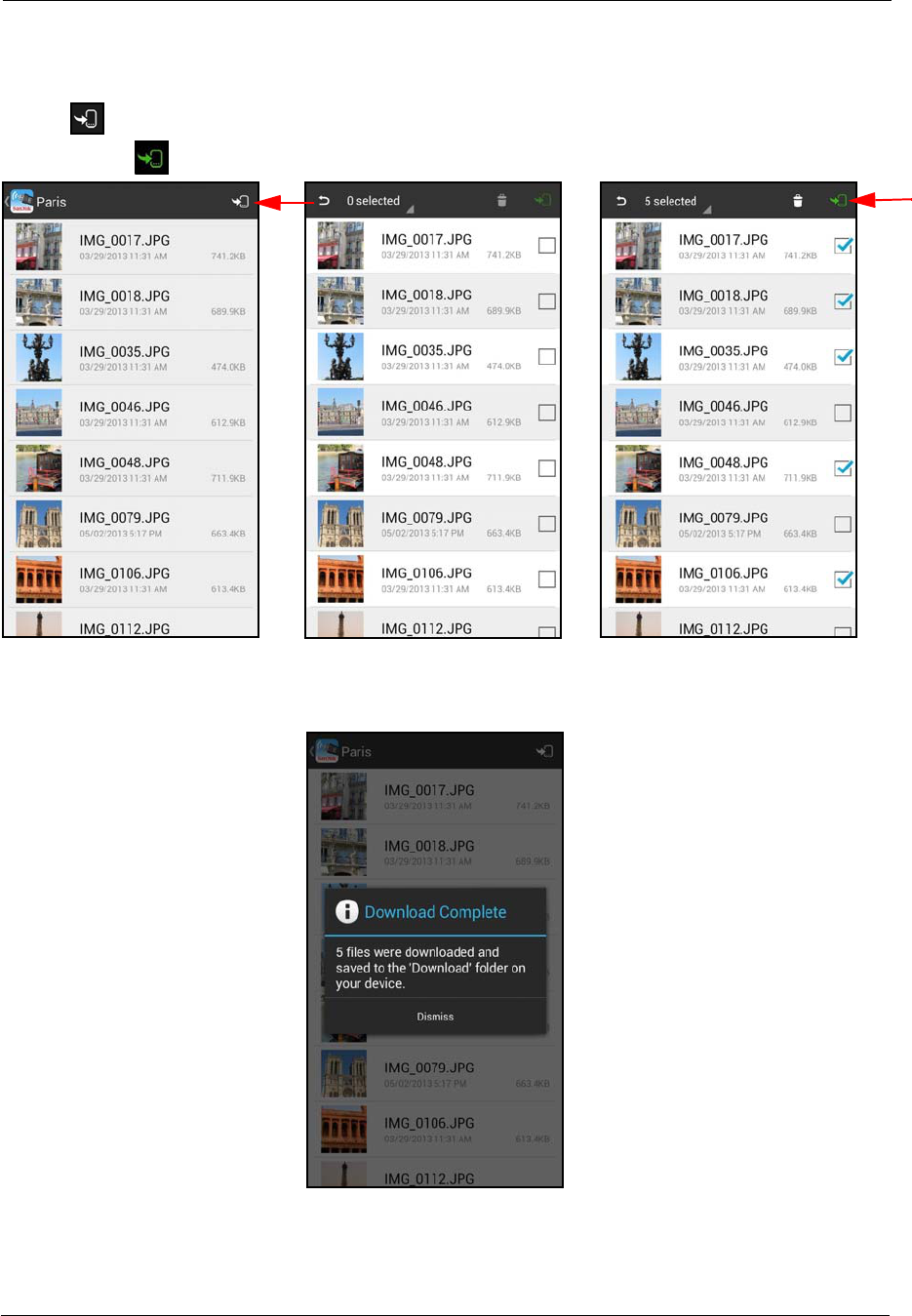
3. Working with Files Moving Files
SanDisk Connect™ Wireless Flash Drive User Manual for Android 22
1. Open the screen showing the files you want to download, tap the Download icon
, select the files to download, and again tap the Download icon, which is now
green ;
ADownload Complete window confirms a successful download and tells you
where to find the downloaded files:
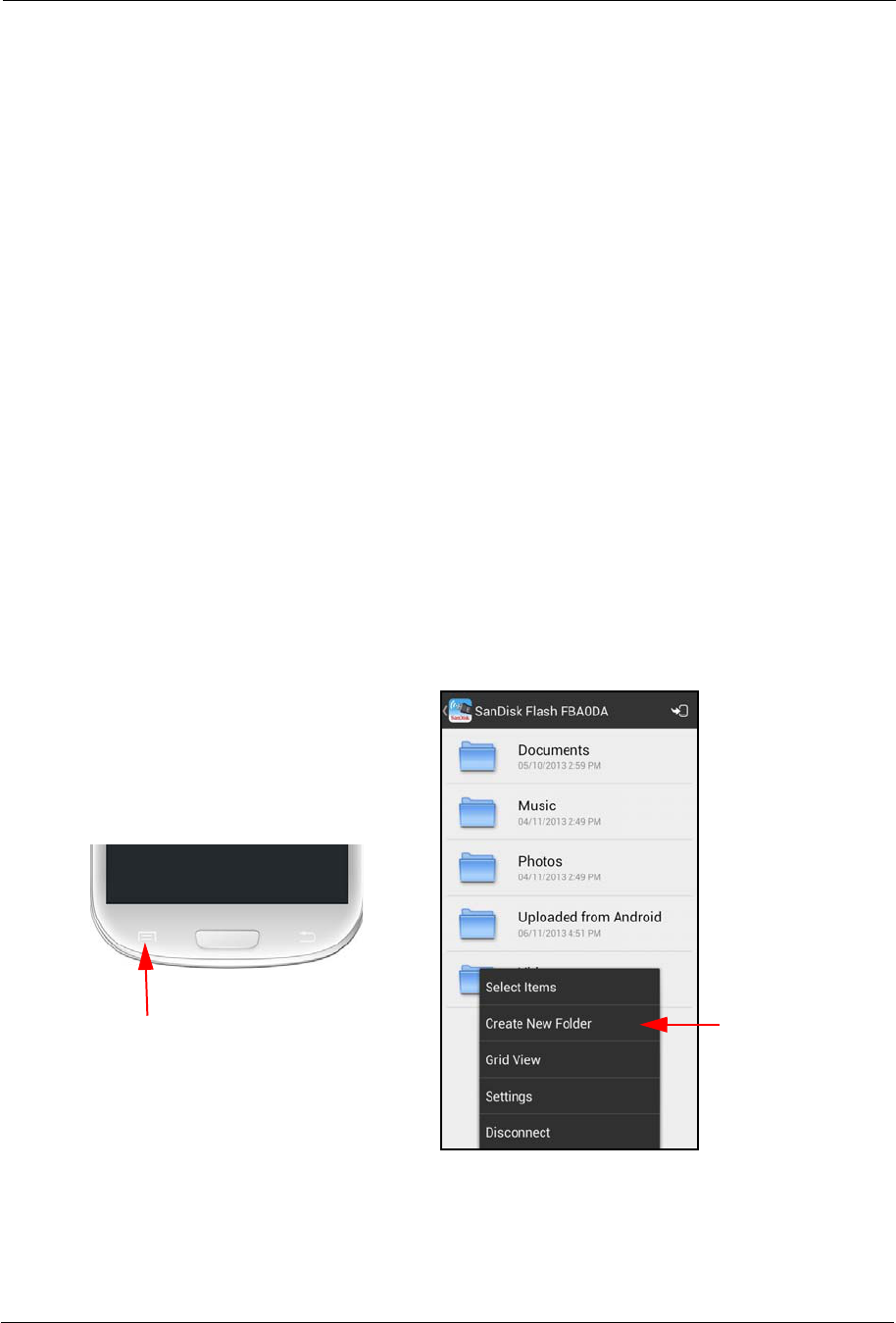
3. Working with Files Moving Files
SanDisk Connect™ Wireless Flash Drive User Manual for Android 23
Uploading Files
When you upload files from a mobile device to your Wireless Drive, you can choose
an existing destination (folder or album) to upload to or you can create a new folder
on the Drive and upload files into it.
You can upload files stored on your mobile device in two ways:
• Access the contents of your Downloads folder or mobile device Gallery from the
Wireless Drive start screen.
• Go directly to content stored in other locations on your mobile device.
Creating a New Folder
One way to create a folder on your Wireless Drive is to connect the Drive to your PC
or Mac and create a folder in the Drive window on the computer. But you can also
create a new folder within the Wireless Drive app on your mobile device, which can
be useful if you want a new folder into which to upload files to your Drive.
To create a new folder,
1. In the Wireless Drive app, navigate to the destination for the new folder, tap your
mobile device Menu button to display the Wireless Drive menu, and tap Create
New Folder:
Menu
button

3. Working with Files Moving Files
SanDisk Connect™ Wireless Flash Drive User Manual for Android 24
2. Enter a name for the new folder and tap Create:
The new folder is displayed on the screen from which you created it.
Uploading Files from the Phone Gallery or Downloads Folder
1. On the Wireless Drive start screen, tap Downloads or Phone Gallery to navigate
to the files you want to upload (the example below uploads photos from the Phone
Gallery):
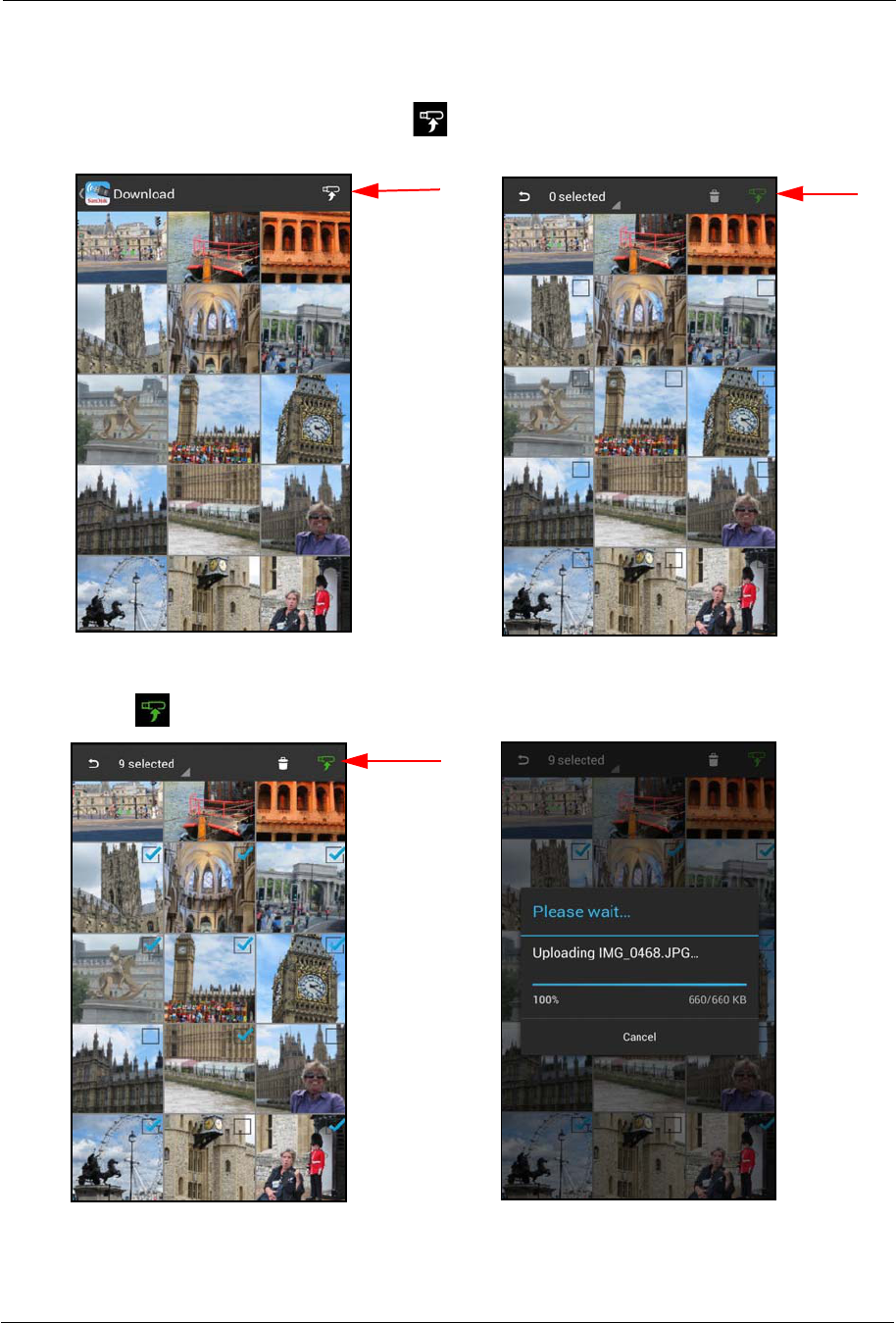
3. Working with Files Moving Files
SanDisk Connect™ Wireless Flash Drive User Manual for Android 25
2. On the screen displaying the files to be uploaded, tap your mobile device Menu
button to display the Upload icon , tap the icon, and select the files for upload
(the selected files are outlined in blue):
3. Again tap the mobile device Menu button, then tap the Upload icon, which is now
green :
4. An Upload Complete window confirms a successful upload and informs you that
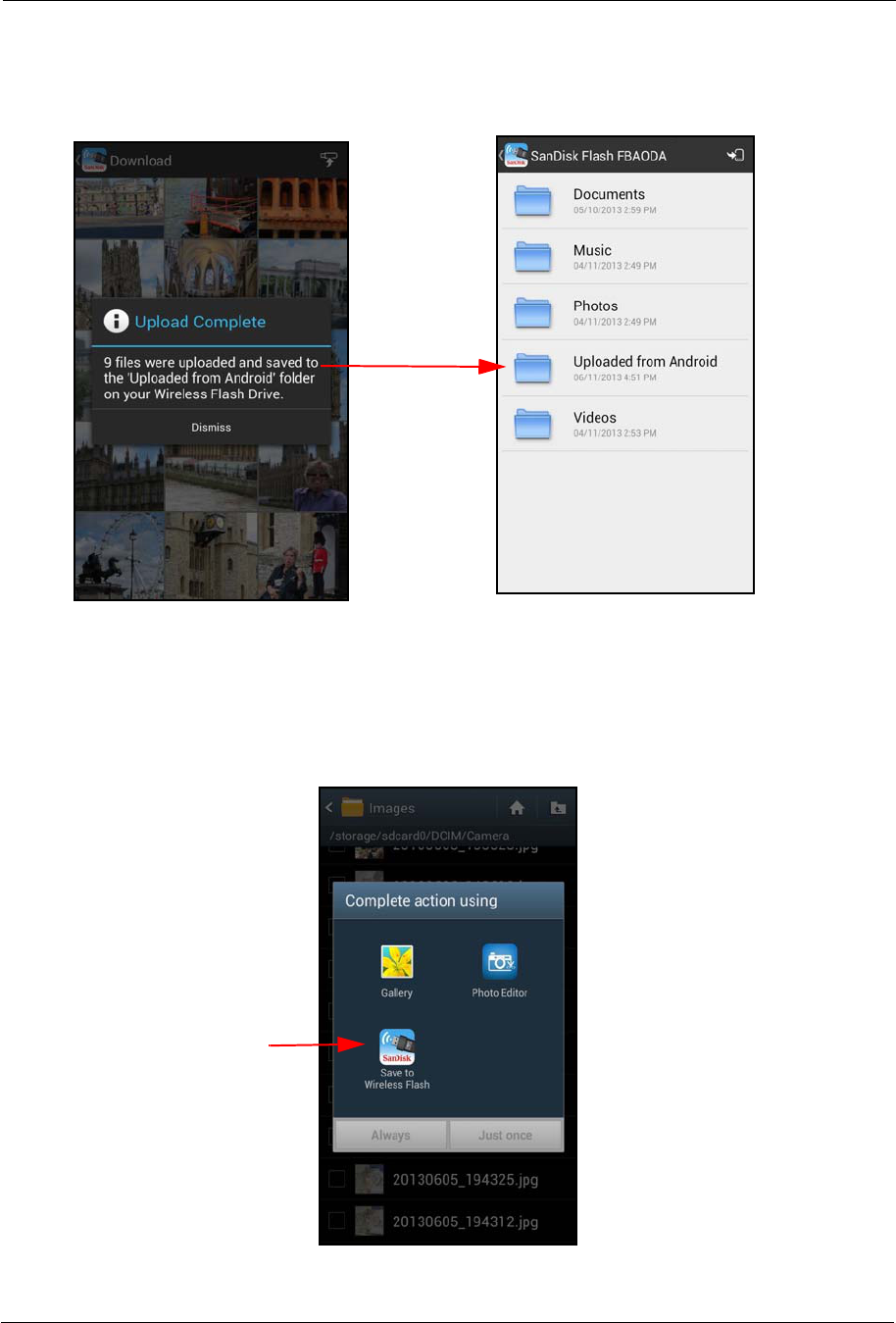
3. Working with Files Moving Files
SanDisk Connect™ Wireless Flash Drive User Manual for Android 26
the uploaded files can be found in the Uploaded from Android folder on your
Drive:
Uploading Files from Other Locations on the Mobile Device
1. On your mobile device, navigate to the file you want to upload.
2. Tap the file, then select Save to Wireless Drive in the Complete action using
window:

3. Working with Files Moving Files
SanDisk Connect™ Wireless Flash Drive User Manual for Android 27
Sharing Files
In addition to handing someone your Wireless Drive to plug into a computer USB
port, you can share files stored on your Drive in two ways:
• Allow others Wi-Fi access to your Wireless Drive so they can use their mobile
devices to connect to the files on your Drive.
• Send files to others via email, social media, messaging, or Bluetooth. The
methods available vary depending upon the features provided on your mobile
device.
Allowing Access to your Wireless Drive
You can allow others to connect directly to your Wireless Drive Wi-Fi network so they
can view your files and download them to their mobile devices.
People can share your files in two ways:
• They can install the free Wireless Drive app on their mobile devices.They do not
need to own their own Wireless Drives.
• They can connect to the Drive’s Wi-Fi network and use a web browser to access
the Drive content at www.sandisk.com/wfd.
Suppose you want to share your files with a friend using the Wireless Drive app:
1. Make sure she’s downloaded the Wireless Drive app from her mobile device
application store.
2. Turn on your Wireless Drive and place it within range (160 feet/50 meters) of your
friend.
3. Tell her the network name of your Drive so she can find it in the list of available
networks in Wi-Fi settings on her mobile device.
4. If your Drive is password-protected, give her the password.
When your friend’s mobile device has connected to your Wireless Drive, she can
open the Wireless Drive app on her mobile device and see your main screen. Now
she can view your files and even download them to her mobile device.
Sending Files to Others
You can share files by sending them to others in a variety of ways: email, social
media, messaging, and Bluetooth, to name a few. The methods available vary
depending upon the features available on your mobile device.
To send a file to someone,

3. Working with Files Deleting Files
SanDisk Connect™ Wireless Flash Drive User Manual for Android 28
1. Browse to the file you want to share, long press on the file to display the file
options, and tap Share:
2. Select a method to share your file and provide the required information. (The
options available on your mobile device vary.)
Deleting Files
You can delete individual files or you can delete an entire folder at one time.

3. Working with Files Deleting Files
SanDisk Connect™ Wireless Flash Drive User Manual for Android 29
Deleting a File
1. Open the screen containing the file you want to delete, long press on the file to
display the file options, and tap Delete file:
2. Tap Delete to confirm that you want to delete this file:
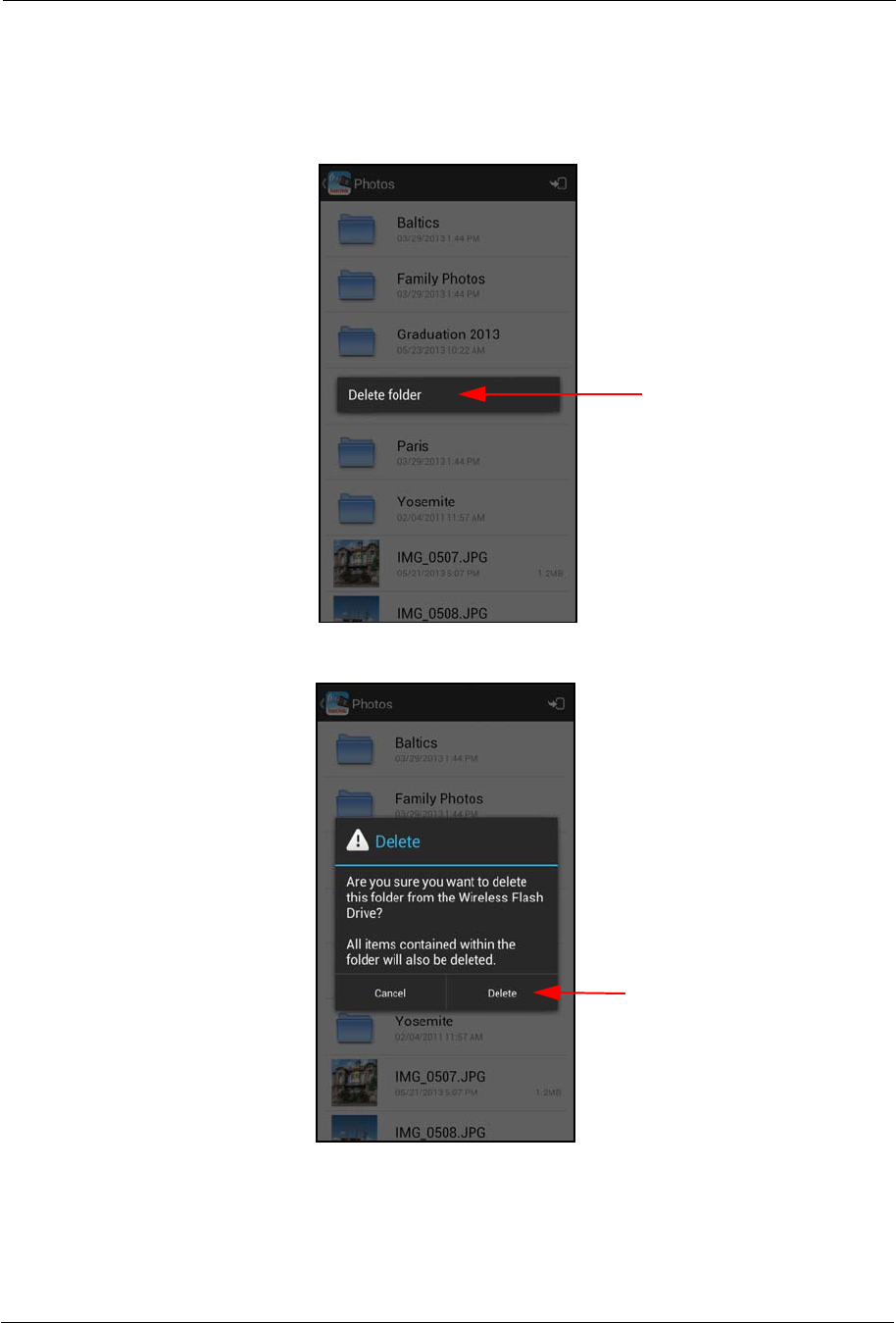
3. Working with Files Deleting Files
SanDisk Connect™ Wireless Flash Drive User Manual for Android 30
Deleting a Folder
1. Long press on a folder and tap Delete folder:
2. Tap Delete to confirm that you want to delete this folder:

3. Working with Files Unsupported File Formats
SanDisk Connect™ Wireless Flash Drive User Manual for Android 31
Unsupported File Formats
The Wireless Drive app can open all file formats that are supported by your mobile
device. If you try to open an unsupported file format, a message informs you that this
file type is not supported:
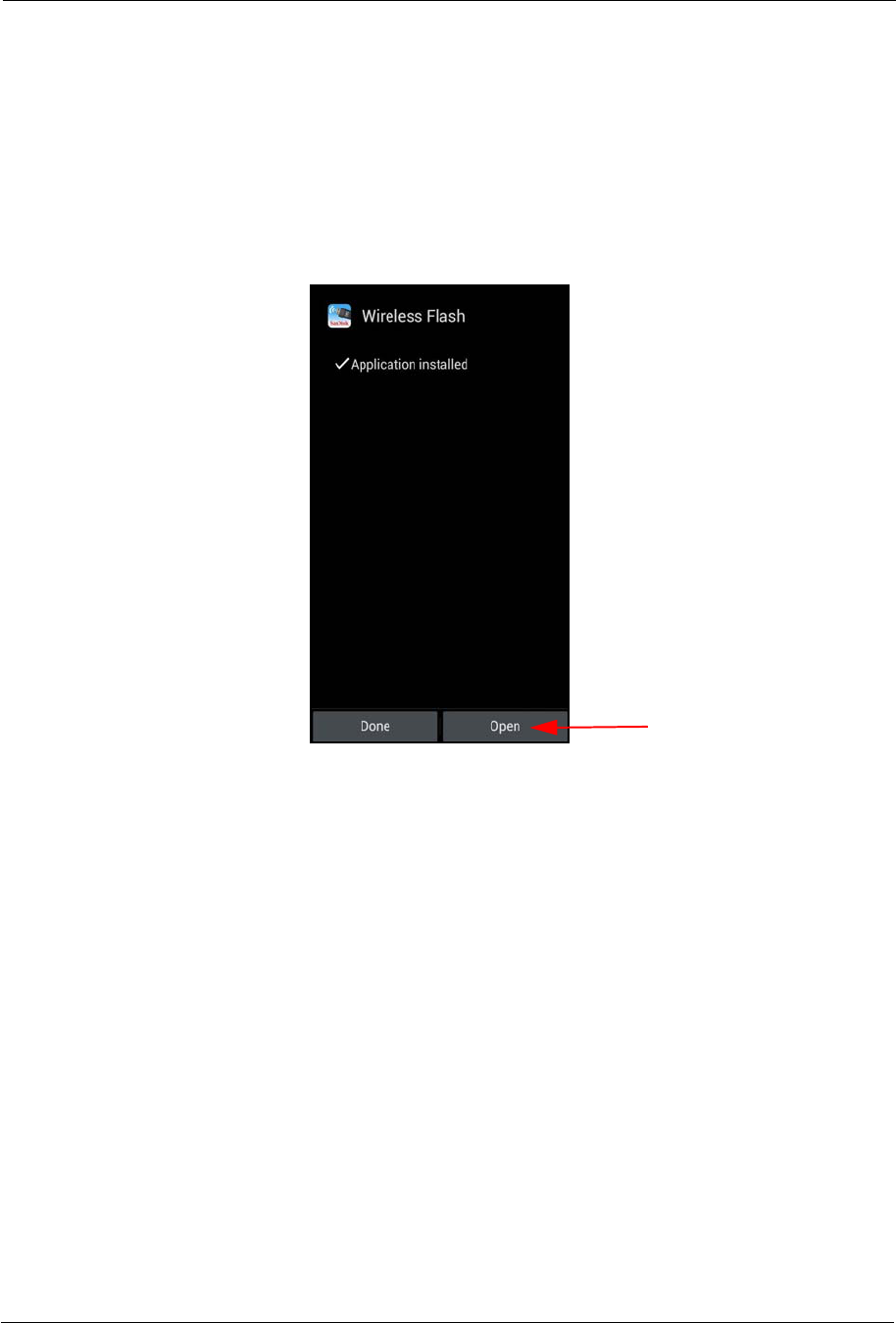
4. Managing the Wireless Drive Updating the Firmware
SanDisk Connect™ Wireless Flash Drive User Manual for Android 32
4. Managing the Wireless Drive
Updating the Firmware
New Firmware is made available just like any other application update.
1. Install the Firmware upgrade:
2. Tap Open to launch the Wireless Flash Drive app.

4. Managing the Wireless Drive Updating the Firmware
SanDisk Connect™ Wireless Flash Drive User Manual for Android 33
A popup message prompts you to update the Firmware on the Drive:
3. Tap OK.
When the new Firmware has been installed, instructions on how to complete the
update are displayed:
4. Turn off the Drive and connect it to a USB charger or a computer.
Both the blue and the amber LEDs blinking rapidly.

4. Managing the Wireless Drive Updating the App
SanDisk Connect™ Wireless Flash Drive User Manual for Android 34
5. Wait for several seconds after the rapid flashing stops, then eject the Drive from
the charger or computer.
6. Turn the Wireless Drive back on and launch the Wireless Flash Drive app.
Updating the App
You update the Wireless Flash Drive app the same way you update any other app on
your mobile device:
1. Tap your mobile device applications store icon.
2. Go to Menu > My Apps and scroll down to the Wireless
Flash Drive app under Installed.
3. Tap the Wireless Flash Drive app icon.
4. Follow the on-screen instructions to reconnect to the Wireless Drive Wi-Fi network
after the app update.
Managing Wireless Drive Settings
The Wireless Drive Settings screen provides access to all the functions you can
perform in the Wireless Flash Drive app, as well as information about the Drive and
the app.
To open the Settings screen,

4. Managing the Wireless Drive Managing Wireless Drive Settings
SanDisk Connect™ Wireless Flash Drive User Manual for Android 35
• Tap the mobile device Menu button to display the Settings option:
Saving Settings Changes
When you leave the Settings screen after changing a setting, a Settings changed
window confirms that you want to save your change and a Save settings window
advises you to restart your Wireless Drive in order for the new setting to take effect.
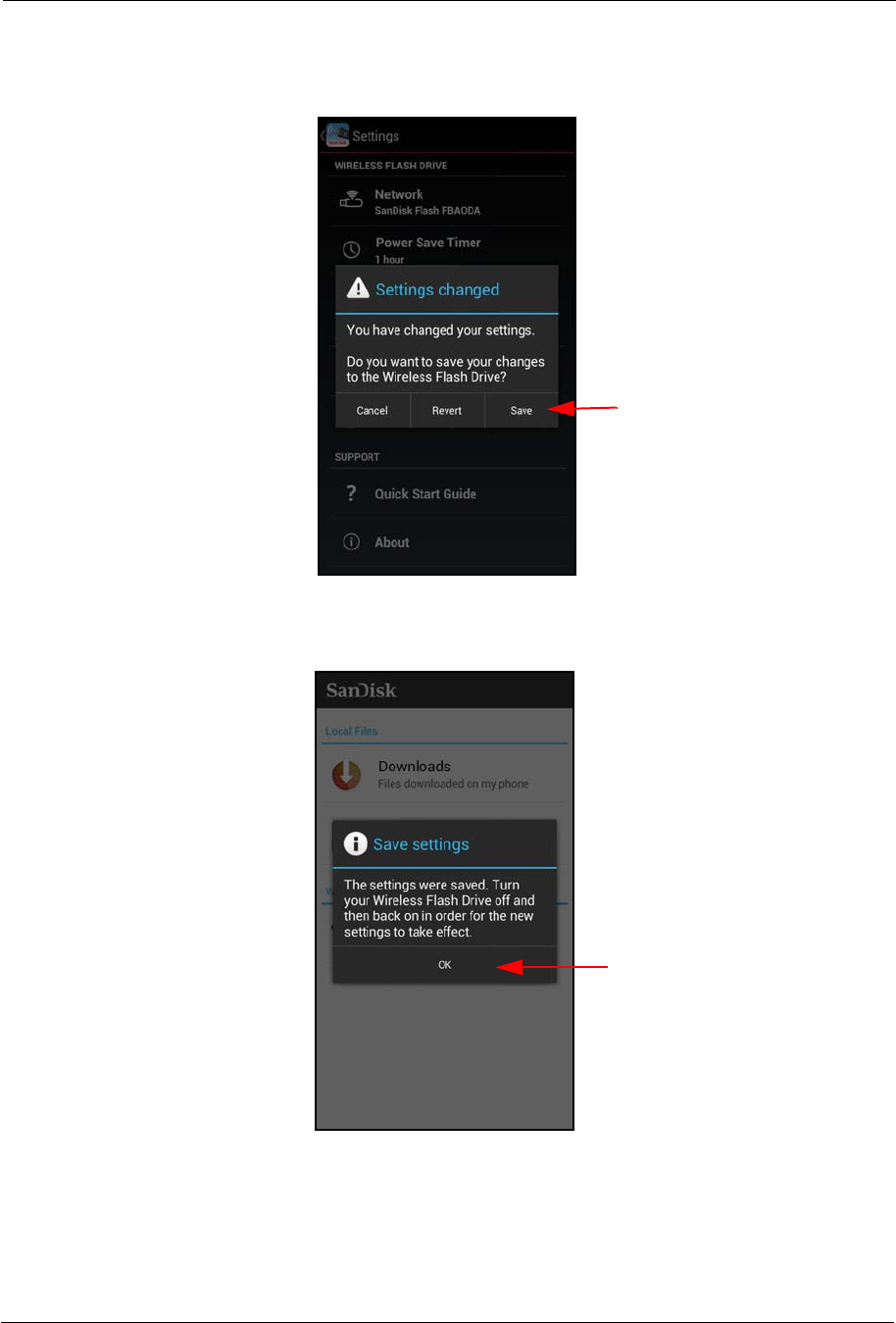
4. Managing the Wireless Drive Managing Wireless Drive Settings
SanDisk Connect™ Wireless Flash Drive User Manual for Android 36
1. In the Settings changed window, tap Save to confirm your changes:
2. In the Save settings window, tap OK to acknowledge that you must restart your
Wireless Drive to complete the setting change:
3. Turn your Wireless Drive off and then back on to complete the change.
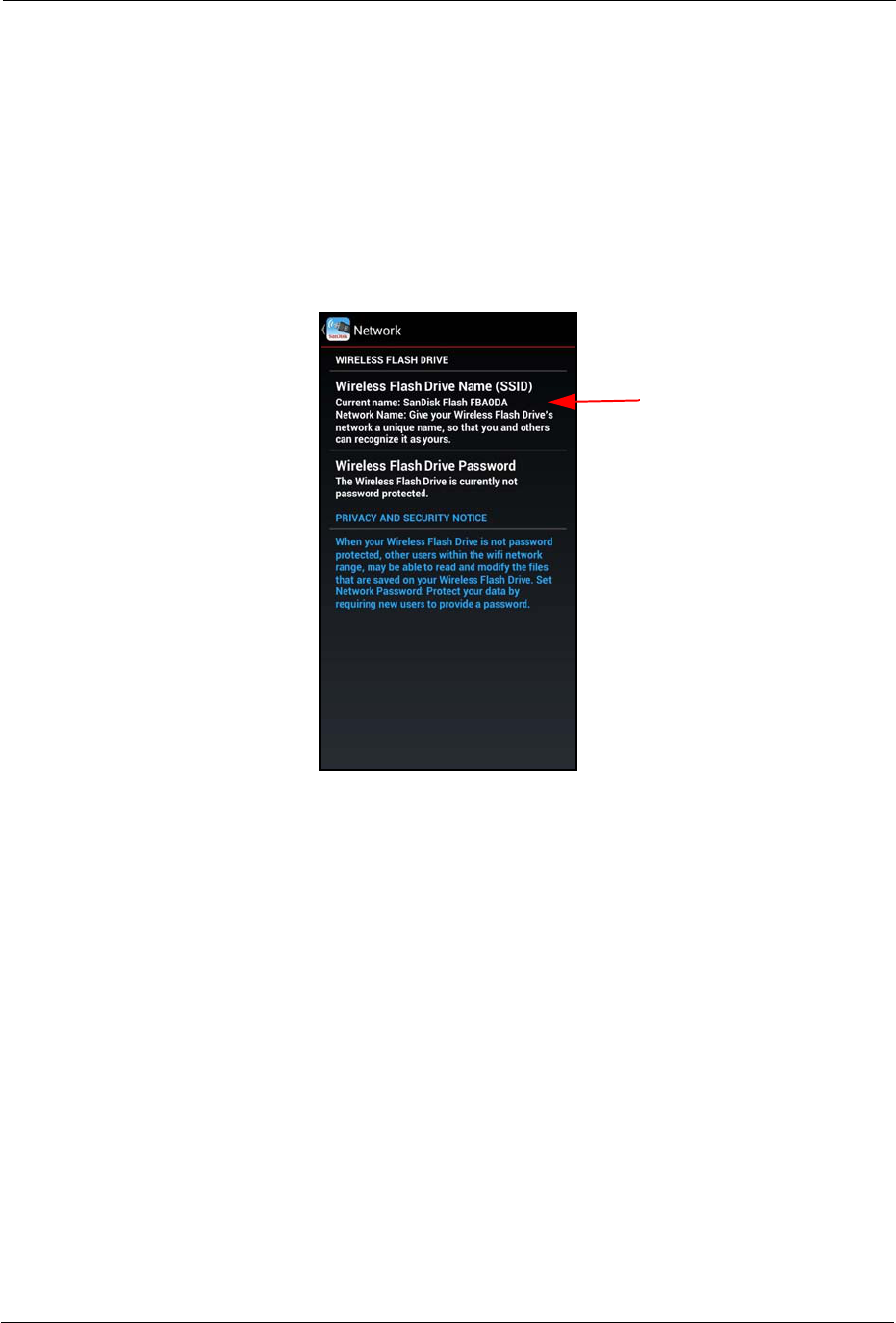
4. Managing the Wireless Drive Managing Wireless Drive Settings
SanDisk Connect™ Wireless Flash Drive User Manual for Android 37
Changing the Wireless Drive Network Name
Your Wireless Drive Wi-Fi network comes uniquely identified as SanDisk Flashxxxxxx
(for example, SanDisk Flash ABCDEF).You can change the network name to make it
easier to identify your Drive.
1. On the Settings screen, tap Network to open the Network screen.
The current name of your Drive Wi-Fi network is displayed:
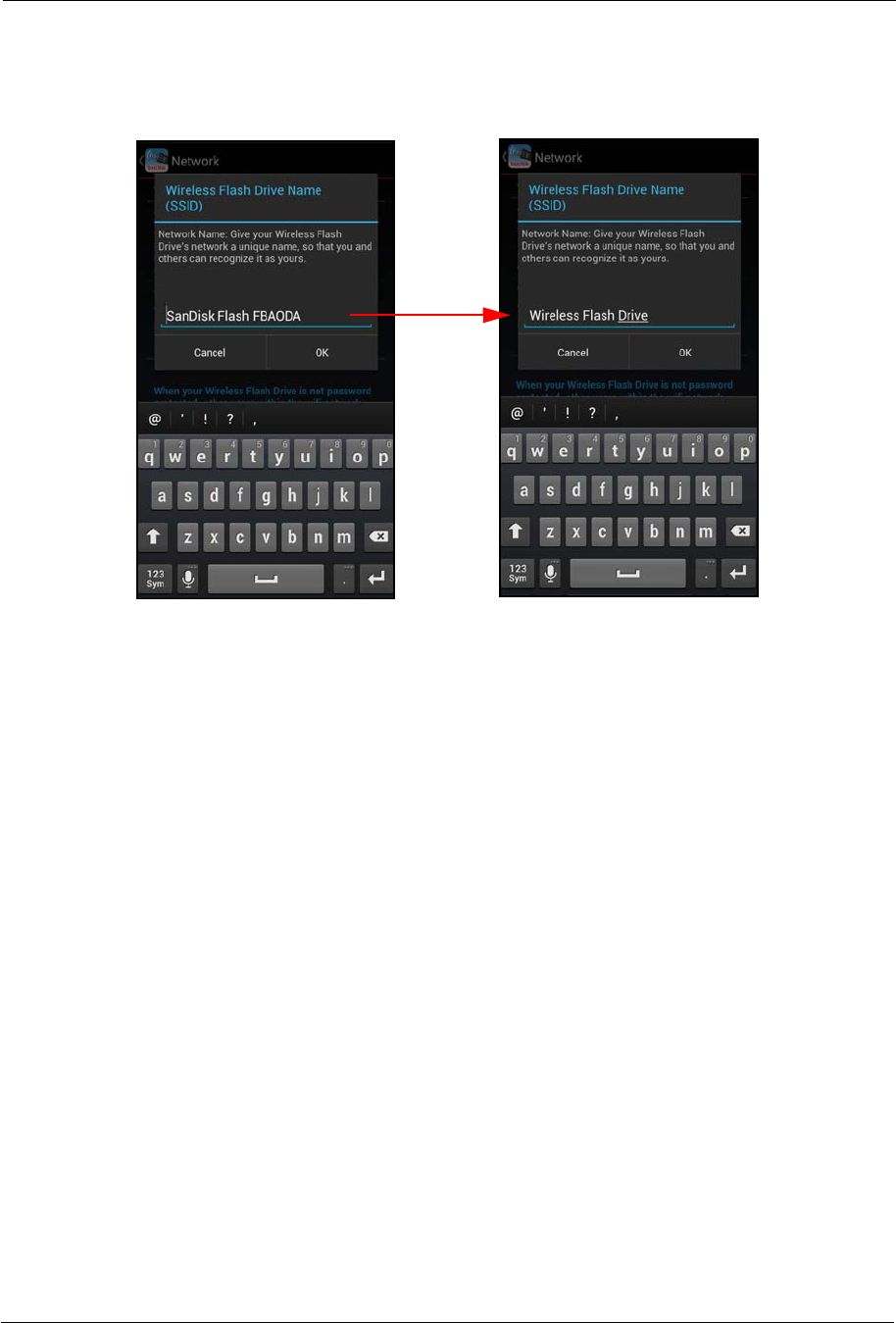
4. Managing the Wireless Drive Managing Wireless Drive Settings
SanDisk Connect™ Wireless Flash Drive User Manual for Android 38
2. Tap the area under the Wireless Drive name to open the Name change window,
enter a new name for the Drive, and tap OK:
3. In the Settings changed window, tap Save to save your changes.
4. In the Save settings window, tap OK to acknowledge that you must restart your
Drive.
5. Turn your Wireless Drive off and then back on to complete the network name
change.
6. On your mobile device, go to Settings > Wi-Fi and tap the new name of your
Wireless Drive to reconnect.
Creating/Changing a Password
The default Wi-Fi security setting is no password. We recommend that you set a Wi-
Fi password so that your Drive contents can’t be accessed by other people within
range (up to 160 feet) of the Wi-Fi network created by the Wireless Drive.
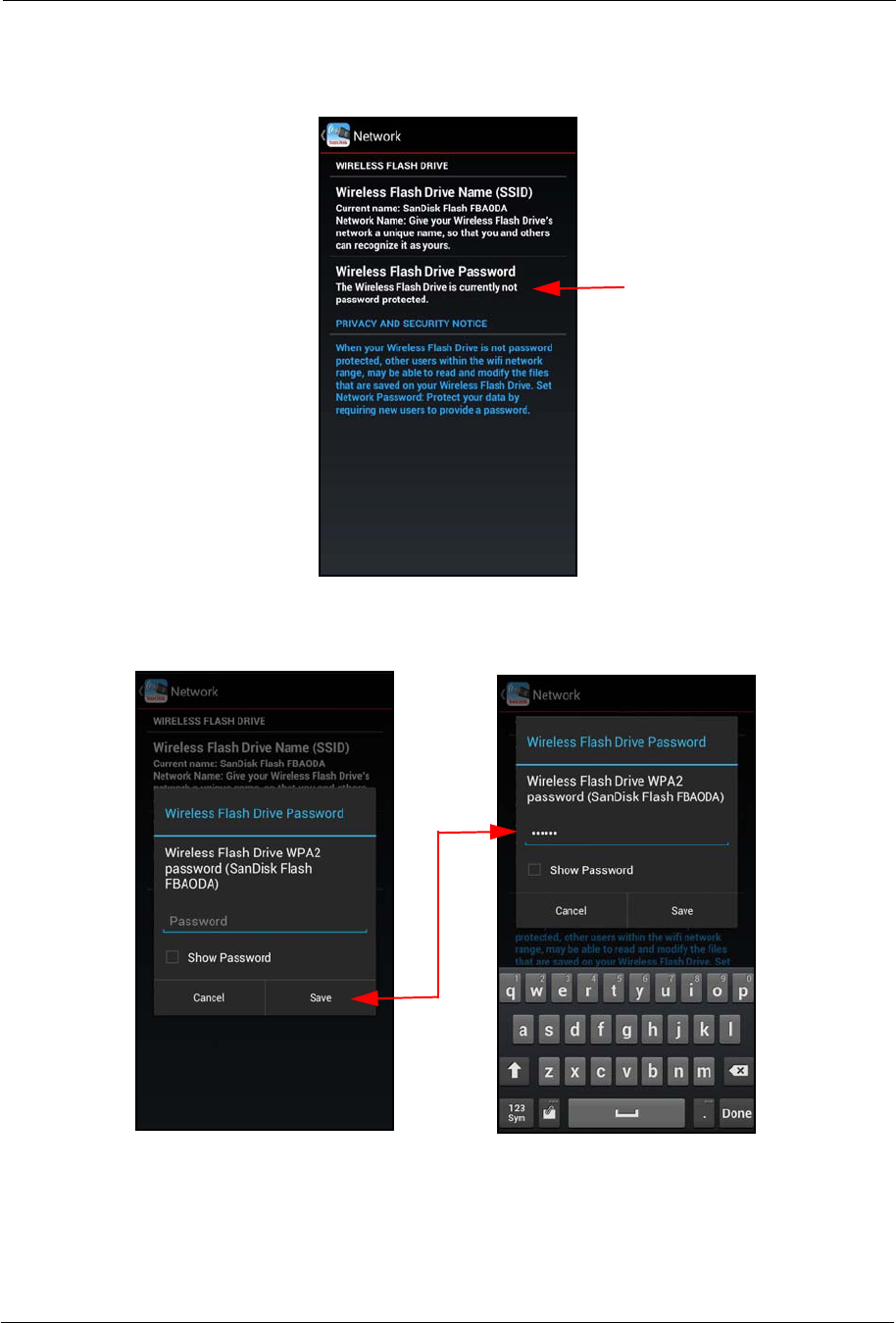
4. Managing the Wireless Drive Managing Wireless Drive Settings
SanDisk Connect™ Wireless Flash Drive User Manual for Android 39
1. On the Settings screen, tap Network to open the Network screen:
2. Tap the area under Wireless Drive Password to open the Wireless Drive
Password window, enter a password, and tap OK:
3. In the Settings changed window, tap Save to save your changes.
4. In the Save settings window, tap OK to acknowledge that you must restart your
Drive.

4. Managing the Wireless Drive Managing Wireless Drive Settings
SanDisk Connect™ Wireless Flash Drive User Manual for Android 40
5. Turn your Wireless Drive off and then back on to complete the password change.
Note: Creating a Wi-Fi password allows you to limit access to your Drive when you connect
directly to it. But the Wi-Fi password does not limit access when your Drive is
connected to an Internet Wi-Fi network, where anyone who has installed the Wireless
Flash Drive app can access your Drive.
Restoring Factory Settings
If you forget your password or if your Wireless Drive becomes unresponsive, you can
reset the Drive to its default factory settings. This erases your password and forces
the Drive to reboot, but it does NOT delete any content stored on the Drive. Once the
Drive has rebooted, you can set a new password.
To reset the Drive,
1. Turn off the Wireless Drive.
2. Hold in the Wi-Fi button for 20 seconds.
After about 20 seconds the amber and blue LEDs flash alternately two times (this
is the actual reset) and the drive resets and stays on.
Setting the Power Save Timer
You can set your Wireless Drive to power down after it’s been idle for a specified
amount of time.
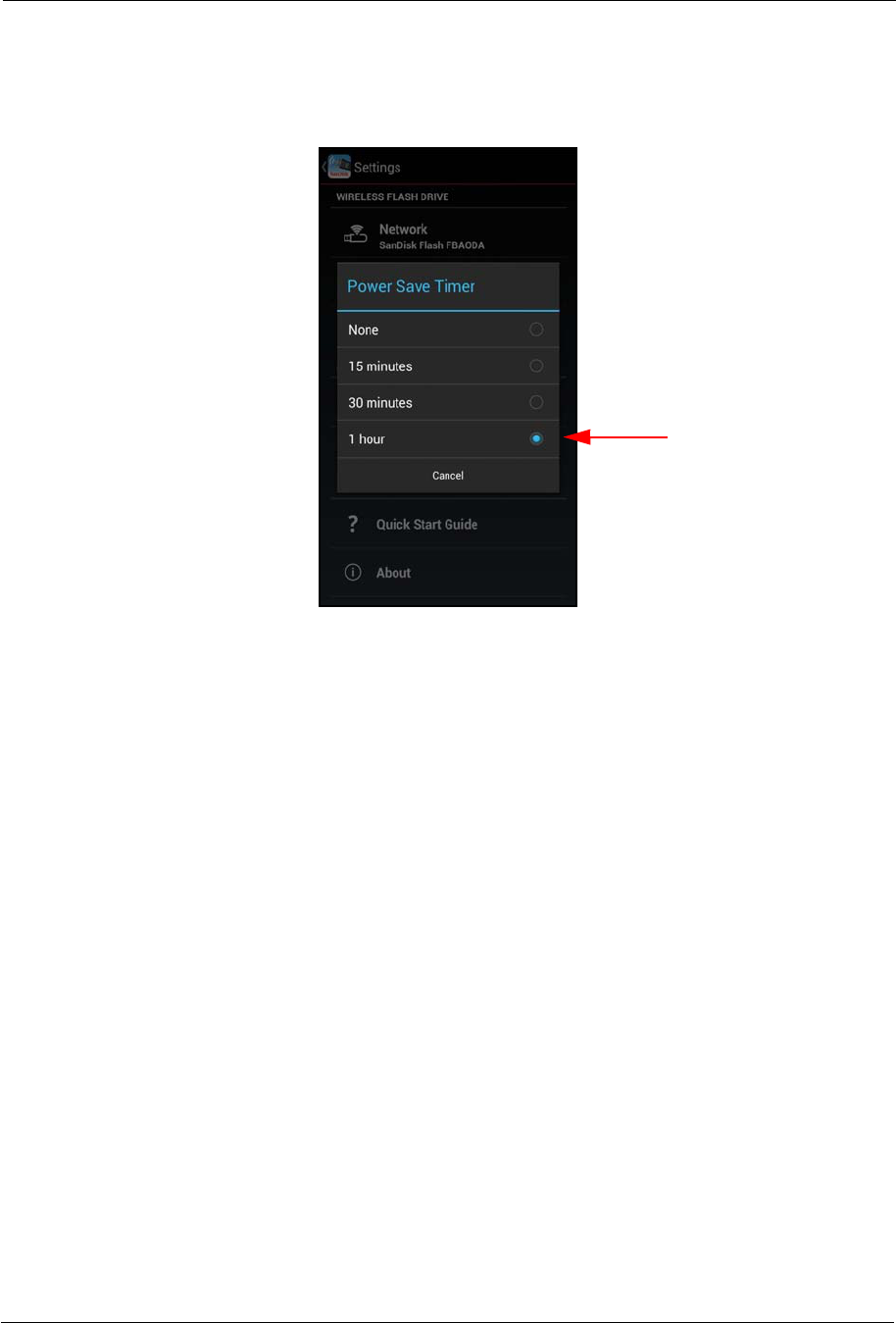
4. Managing the Wireless Drive Managing Wireless Drive Settings
SanDisk Connect™ Wireless Flash Drive User Manual for Android 41
1. On the Settings screen, tap Power Save Timer to open the Power Save Timer
window:
2. Select the desired amount of time.
As soon as you make your selection, the Power Save Timer window closes and
the Settings screen displays the new selection.
Connecting to the Internet
Your mobile device or computer can wirelessly access content on your Drive and at
the same time remain connected to the Internet as long as a wireless Internet
network is available. (Some wireless networks might block this functionality.)
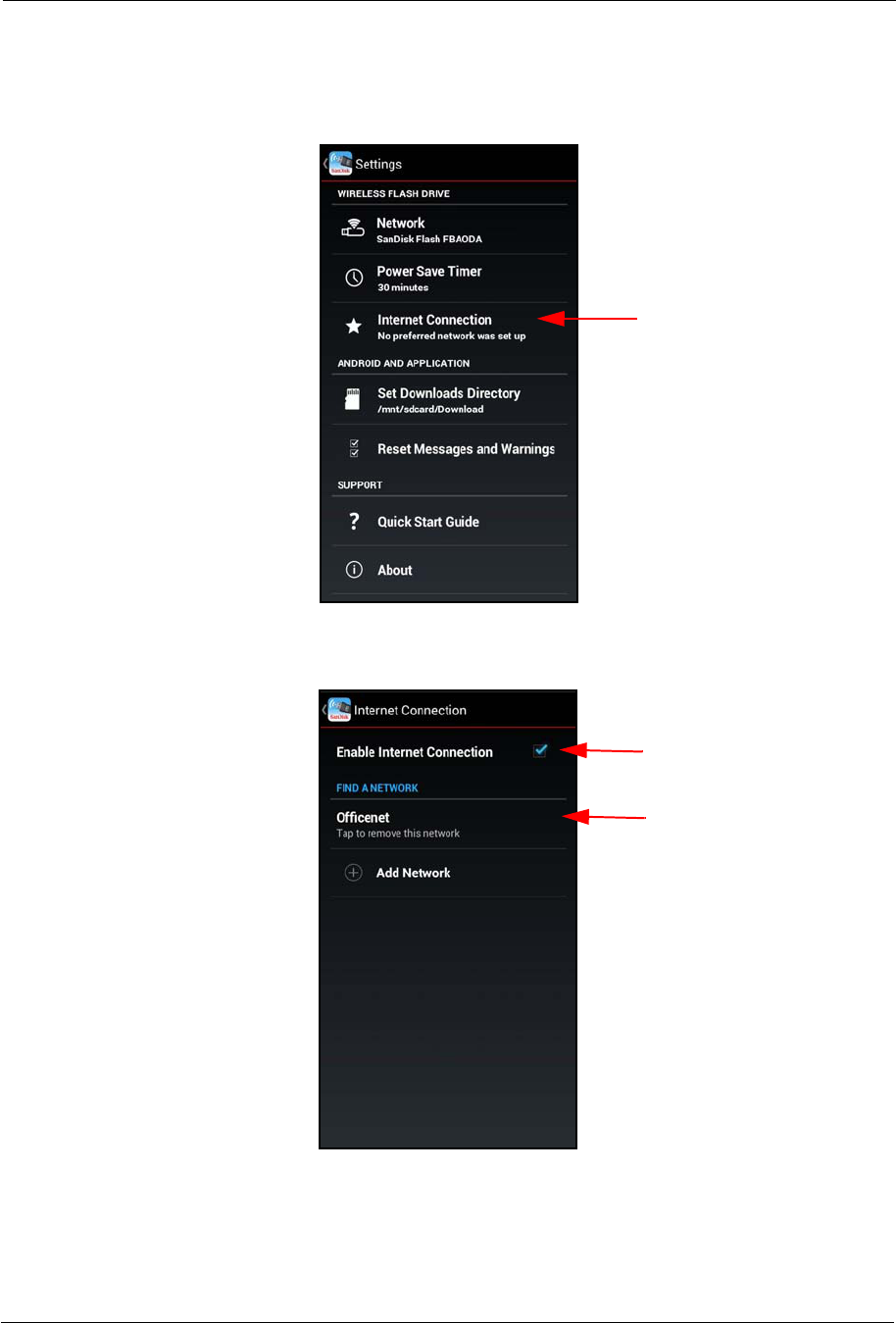
4. Managing the Wireless Drive Managing Wireless Drive Settings
SanDisk Connect™ Wireless Flash Drive User Manual for Android 42
1. On the Settings screen, tap Internet Connection to open the Internet
Connection screen:
2. Turn on Enable Internet Connection and select the desired network from the list
of Preferred Networks, then exit the Flash Drive app:
3. On your mobile device, go to Settings > Wi-Fi and connect to the Preferred
Network you selected in the app.
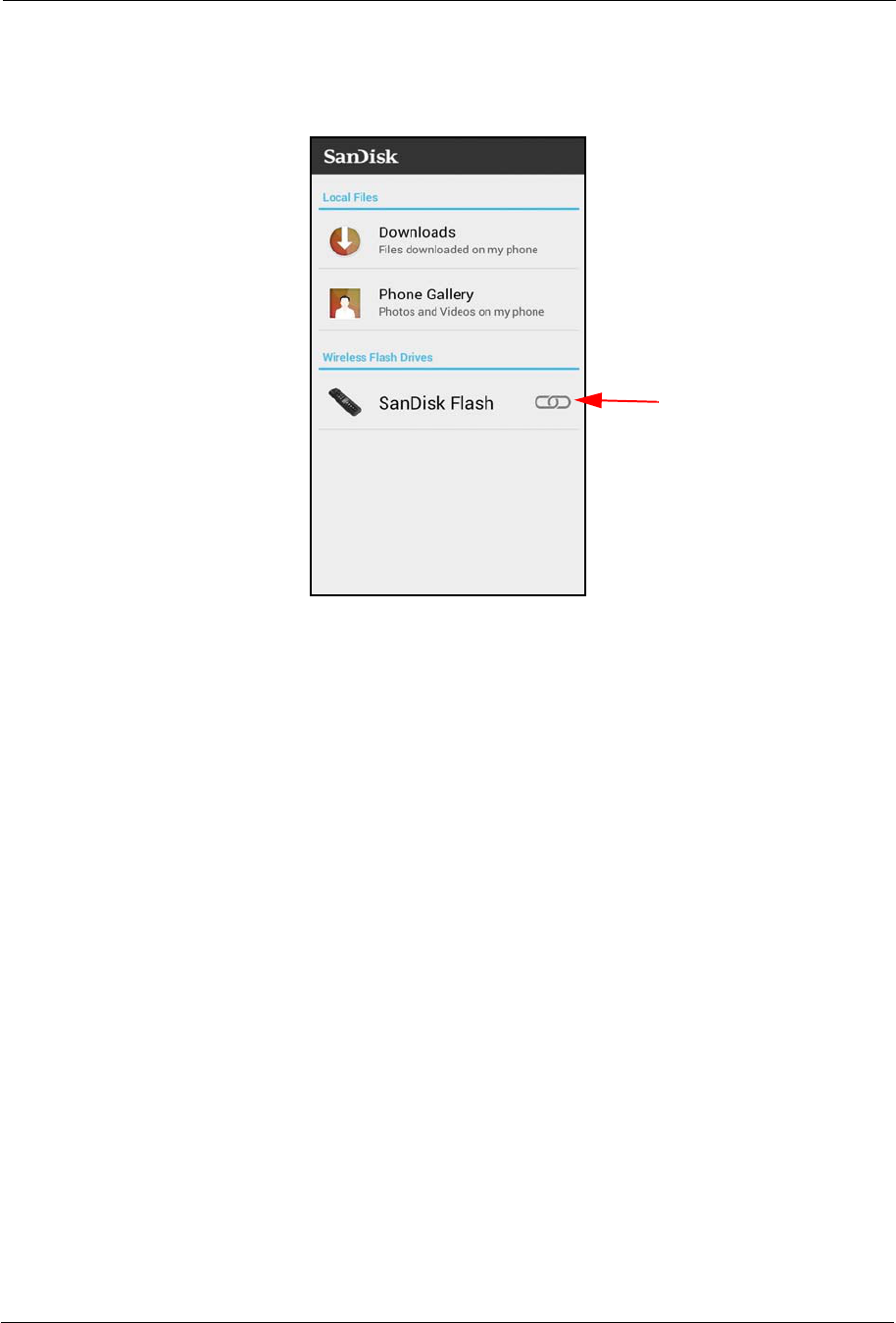
4. Managing the Wireless Drive Managing Wireless Drive Settings
SanDisk Connect™ Wireless Flash Drive User Manual for Android 43
Your Wireless Drive start screen indicates that your mobile device is connected to
the Internet:
You're now connected to both the Wireless Drive and the Internet. Whenever your
mobile device connects to this Internet network and you launch the Wireless Drive
app, the mobile device will automatically find the Drive.
Adding a Preferred Network
Once you identify an Internet Wi-Fi network (for example, a home, office, or coffee
shop network) as a Preferred Network, the Wireless Flash Drive app recognizes it
and automatically connects to it each time you launch the app within range of that Wi-
Fi network.
To add a Preferred Network,
Internet Connection
icon
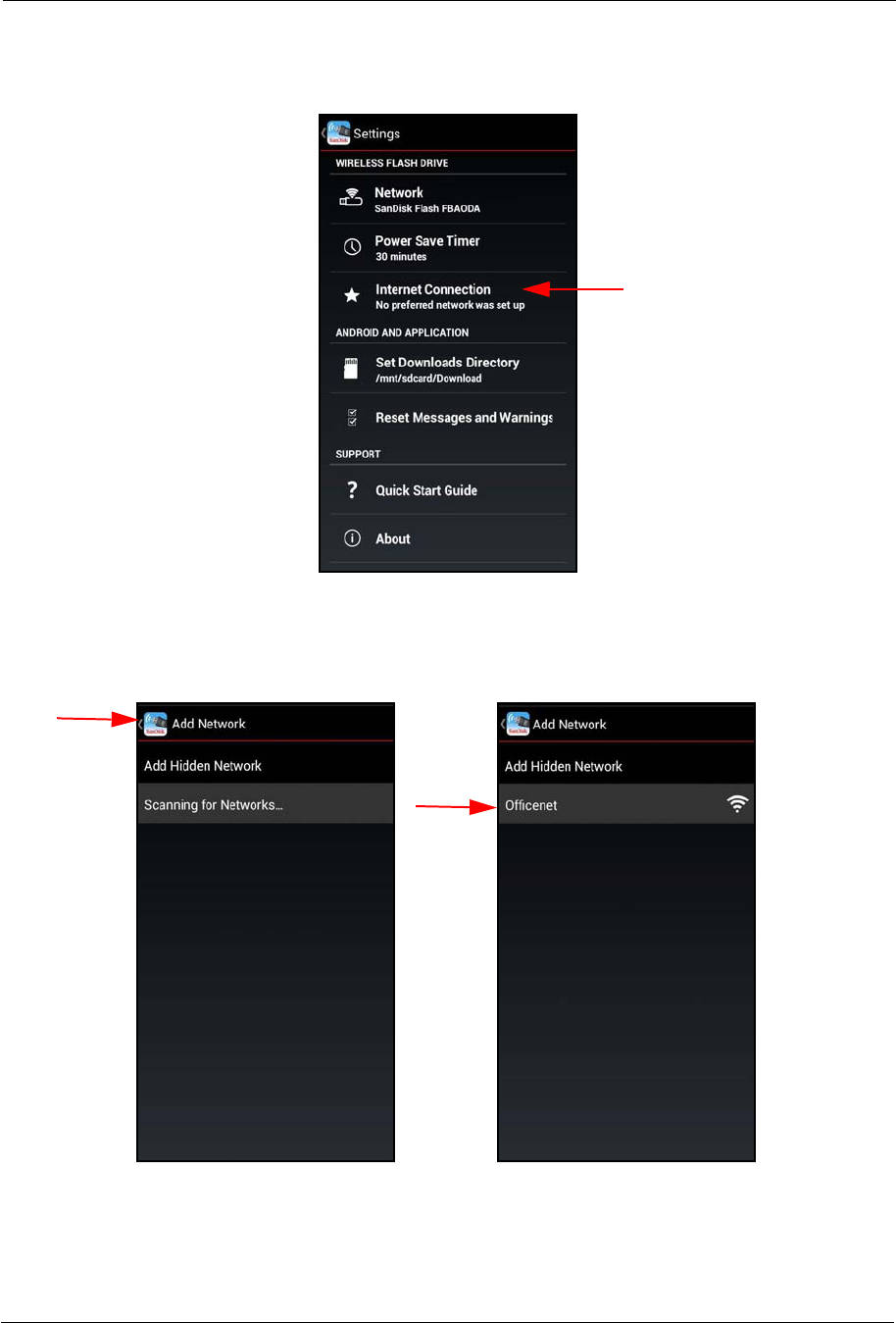
4. Managing the Wireless Drive Managing Wireless Drive Settings
SanDisk Connect™ Wireless Flash Drive User Manual for Android 44
1. On the Settings screen, tap Internet Connection:
2. On the Internet Connection screen, tap Add Network and wait while the app
scans for available networks, then select the network to be added as a Preferred
Network:

4. Managing the Wireless Drive Managing Wireless Drive Settings
SanDisk Connect™ Wireless Flash Drive User Manual for Android 45
A window confirms that your Wi-Fi network is now a Preferred Network:
3. On your mobile device, go to Settings > Wi-Fi and select the Preferred Network.
4. Turn the Wireless Flash Drive off, then back on to complete the Internet
connection.
From now on, whenever you launch the Wireless Drive app within range of the
Preferred Network, it will automatically find your Wireless Drive so you can surf the
Internet while you access the content on the Drive.

4. Managing the Wireless Drive Managing Wireless Drive Settings
SanDisk Connect™ Wireless Flash Drive User Manual for Android 46
Setting the Downloads Directory
The default Downloads directory on the Wireless Drive comes is the Download folder
located on your mobile device:
You can change the location at which you want to download files from the Wireless
Drive.
1. On the Settings screen, tap Set Downloads Directory:

4. Managing the Wireless Drive Managing Wireless Drive Settings
SanDisk Connect™ Wireless Flash Drive User Manual for Android 47
2. Navigate to any existing folder on the mobile device until you reach a new
destination for your downloads, then tap Select:
From now on, your downloaded files will be stored in the new directory.
Resetting Messages and Warnings
In several Message and Warning pop-up windows in the Wireless Drive app, you’re
offered the option of electing not to see those messages again. However, you can
always change your mind and reset Messages and Warnings so that those windows
again appear.
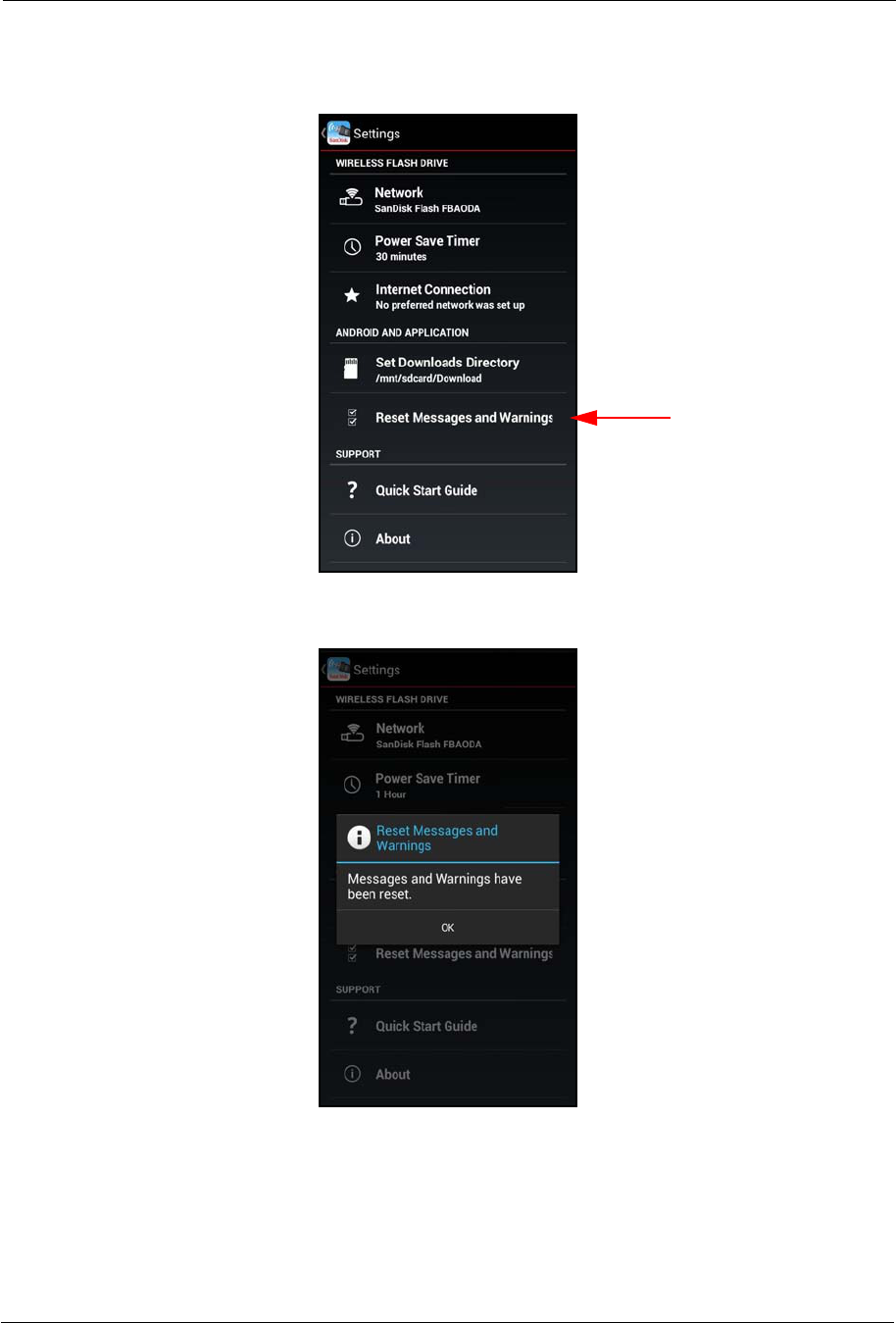
4. Managing the Wireless Drive Managing Wireless Drive Settings
SanDisk Connect™ Wireless Flash Drive User Manual for Android 48
1. On the Settings screen, tap Reset Messages and Warnings:
A message confirms that you will once again see messages and warnings:

4. Managing the Wireless Drive Managing Wireless Drive Settings
SanDisk Connect™ Wireless Flash Drive User Manual for Android 49
Getting Support
Quick Start Guide
• On the Settings screen, tap Quick Start Guide for information about setting
up your Wireless Drive:
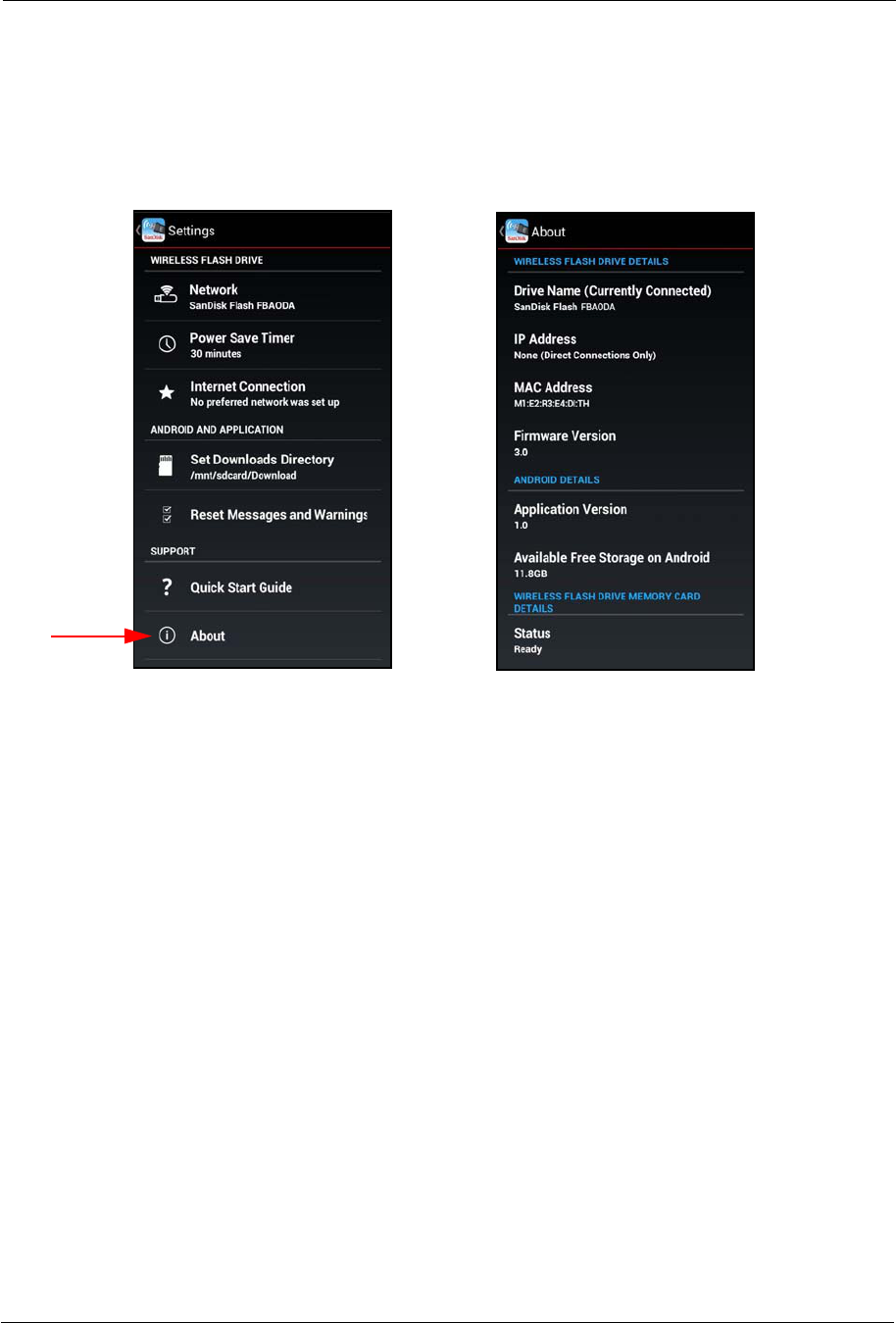
4. Managing the Wireless Drive Managing Wireless Drive Settings
SanDisk Connect™ Wireless Flash Drive User Manual for Android 50
About
•Tap About for details about your Wireless Drive, your mobile device, the
memory card currently inserted in your Drive, and legal information related to
the product

5. Product and Safety Information Product Specifications
SanDisk Connect™ Wireless Flash Drive User Manual for Android 51
5. Product and Safety Information
Product Specifications
1Based on streaming 720p content at 2mbps to one device; actual life and performance may vary
depending upon usage and settings; battery not replaceable.
Regulatory Information
FCC Compliance Statement: This device complies with Part 15 of the FCC Rules.
Operation is subject to the following two conditions: (1) This device may not cause
harmful interference, and (2) This device must accept any interference received,
including interference that may cause undesired operation.
Dimensions 78mm x 27mm x14mm (3.1'' x 1'' x 0.5'')
Weight 27gr (0.95 oz)
Memory Card Class 10 SanDisk Ultra microSDHC™ up to 32GB
1GB=1,000,000,000 bytes. Actual user storage less.
Battery Type Built-in, non-replaceable rechargeable lithium polymer battery
Operating Duration Up to 4 hours of continuous usage1
Battery Charging Using a USB 2.0-powered connection (500mA): up to 2 hours
for full charge (device cannot be used wirelessly while
charging via a USB connection)
Drive can be used wirelessly while charging via a compatible
USB power adapter (turn Drive on before plugging it into an
adaptor)
USB Connectivity USB 2.0 High Speed
Wireless Connectivity Wi-Fi: IEEE 802.11 b/g/n (2.4GHz)
Wireless Range Up to 160 feet (50m) line-of-sight
Wireless Security WPA2
Environmental Requirements Operating temperature: 0°C to 45°C (32°F to 113°F)
Non-operating temperature: 20°C to 45°C (-4°F to 113°F)
Relative humidity: 5% to 95% non-condensing
Maximum operating altitude: 3,000m (10,000 feet)
Maximum File Size ч4GB
Wireless Access System
Requirements
Wi-Fi 802.11 b/g/n 2.4GHz capable device
Native iOS or Android™ app, Web browser, WebDAV client
USB Access System
Requirements
Compatible with most operating systems that support USB
Mass Storage Class

5. Product and Safety Information Regulatory Information
SanDisk Connect™ Wireless Flash Drive User Manual for Android 52
Note: This equipment has been tested and found to comply with the limits of a Class
B digital device, pursuant to Part 15 of the FCC Rules. These limits are designed to
provide reasonable protection against harmful interference in a residential
installation. This equipment generates, uses, and can radiate radio frequency energy
and if not installed and used in accordance with the instructions, may cause harmful
interference to radio communications. However, there is no guarantee that
interference will not occur in a particular installation. If this equipment does cause
interference to radio or television reception, which can be determined by turning the
equipment off and then on, the user is encouraged to try to connect the interference
by one or more of the following measures:
• Reorient or relocate the receiving antenna.
• Increase the separation between the equipment and receiver.
• Connect the equipment to a different outlet so that the equipment and receiver are
on different branch circuits.
• Consult the dealer or an experienced radio/TV technician for help.
Important: Changes or modifications to this product not authorized by SanDisk could
void the electromagnetic compatibility (EMC) and wireless compliance and negate
your authority to operate the product. This product has demonstrated EMC
compliance under conditions that include the use of compliant peripheral devices and
shielded cables between system components. It is important that you use compliant
peripheral devices and shielded cables between system components to reduce the
possibility of causing interference to radios, televisions, and other electronic devices.
Radiation Exposure: This device complies with the FCC's radio frequency radiation
exposure limits set forth for general population/uncontrolled environment. To
maintain compliance, this device must not be collocated or operated in conjunction
with any other antenna or transmitter.The product complies with the FCC portable RF
exposure limit set forth for an uncontrolled environment and is safe for intended
operation as described in this manual. Further RF exposure reduction can be
achieved if the product is kept as far as possible from the user’s body or the device is
set to a lower power output if such a function is available.
EU Disposal Information: Disposal & Recycling - Applicable in the European Union
and other countries with separate collection systems. To prevent possible harm to the
environment or human health from uncontrolled waste disposal, please separate the
SanDisk Connect Wireless Flash Drive from other types of wastes and recycle it
responsibly to promote the sustainable reuse of material resources. Household users
should contact either the retailer where they purchased this product, or their local
government office, for details of where and how they can take this item for
environmentally safe recycling. Business users should contact their supplier and

5. Product and Safety Information Safety and Care
SanDisk Connect™ Wireless Flash Drive User Manual for Android 53
check the terms and conditions of the purchase contract. This product should not be
mixed with other commercial waste for disposal.
Recycling SanDisk Connect Wireless Flash Drive: Do not dispose of either the
SanDisk Connect Wireless Flash Drive with your household waste. In some countries
or regions, collection systems are set up to handle electrical and electronic waste
items. Contact your regional authorities for more details. If collection systems are not
available, please return unwanted accessories to any SanDisk Approved Service
Center in your region.
EU Declaration of Conformity: Hereby, SanDisk declares that this SanDisk
Connect Wireless Flash Drive is in compliance with the essential requirements and
other relevant provisions of Directive 1999/5/EC.
EN 300 328 v1.7.1 (2006-10)
EN 301 489-17 v1.3.2 (2008-04)
EN 62311: 2008
Safety and Care
All wireless devices are susceptible to interference which might affect the
performance of a Wireless Flash Drive.
Do not switch on a Wireless Flash Drive in restricted areas or areas where wireless
devices are prohibited. When instructed to do so, switch off the Wireless Flash Drive
in restricted areas such as those near medical equipment, fuel/chemicals, or blasting
areas, or when instructed to in aircraft.
The Wireless Drive contains a lithium polymer battery that has been fully tested for
safety. However, several precautions should be taken when using a Wireless Drive:
• When a Wireless Drive is in a pocket with other metallic objects, make sure the
cap is in place.
• Never charge a Wireless Drive unattended.
• Charge a Wireless Drive in an area away from flammable materials.
• Never intentionally heat a Wireless Drive in a microwave oven or dryer or place it
a fire. Never use the Wireless Drive in temperatures above 60°C(140°F).
• Stop using a Wireless Drive if any abnormal heat, odor, deformation,
discoloration, or other abnormal condition is detected. If any liquid leaks from a
Wireless Drive, wash your hands well with fresh water immediately. If liquid gets
into your eyes, wash with edible oil and see a doctor immediately.
The Wireless Flash Drive is not water resistant.

5. Product and Safety Information Cleaning
SanDisk Connect™ Wireless Flash Drive User Manual for Android 54
Do not store a Wireless Flash Drive in extreme temperatures. High temperatures can
shorten the life of the device by damaging the battery or cause warping or melting of
the plastic enclosure. Cold temperatures can also shorten the life of the Drive by
damaging the battery, causing the plastic enclosure to crack, or causing moisture to
condense on or inside the device.
Keep the Wireless Flash Drive dry. Water or other liquids can damage it. In addition,
high humidity can cause condensation to form. If a Wireless Flash Drive gets wet,
turn it off, place it in a low-humidity environment, and allow it to completely dry.
Do not store a Wireless Flash Drive in a dusty or dirty area because mechanical parts
may be damaged or cease to work.
Do not attempt to open or modify a Wireless Flash Drive. It contains no internal
serviceable parts. Attempting to modify a Wireless Flash Drive can damage the
device and cause it to operate in violation of government regulations and can cause a
safety concern.
Do not drop, shake, strike, crush, or blend a Wireless Flash Drive as this may
damage the device.
If a Wireless Flash Drive becomes damaged, halt use immediately.
Cleaning
Before cleaning a Wireless Flash Drive, disconnect it from any USB port or cable,
turn off Wi-Fi, and remove the memory card from the card slot. If the outside of the
Wireless Flash Drive is soiled, use a cloth that has been slightly dampened with water
to clean the outside. Do not allow water to enter the Wireless Flash Drive around the
power button, USB connector, or card slot.
If foreign material enters the Wireless Flash Drive through the card slot, attempt to
free it by lightly shaking the Drive with the card slot facing down. If this does not work,
try using a can of compressed air.
Maintenance and Storage
The Wireless Flash Drive contains a lithium polymer battery that needs proper care
for best usage. Note that while the lithium polymer battery does not have any memory
effect, proper care is required for the best usage.
Standard Maintenance
For proper maintenance of the battery, it is best to periodically let the Wireless Flash
Drive discharge. We do not recommended keeping the Wireless Flash Drive plugged

5. Product and Safety Information Maintenance and Storage
SanDisk Connect™ Wireless Flash Drive User Manual for Android 55
in. For the best battery life, we recommend charging and discharging the Wireless
Flash Drive battery at least once a month.
Long Term Storage
If the Wireless Flash Drive will not be used, it is best to keep the battery around 50%
charged. To charge the battery to approximately 50%, fully discharge the Wireless
Flash Drive until it turns itself off, then let it charge for 1 hour. Store the Wireless
Flash Drive at a temperature between 20° C and 45° C (4° F and 113° F) at a relative
humidity of 65% ± 20%.
Recycling
Please recycle all the Wireless Flash Drive packaging.
When the Wireless Flash Drive has reached the end of its useful life, return it to a
recycling station in your community to prevent uncontrolled waste disposal and
dispose of the battery properly.

SanDisk Connect™ Wireless Flash Drive User Manual for Android 56
Index
A
accessing files through the Wireless Drive app 15
accessing the Drive without an app 7
allowing access to your Wireless Drive 27
application overview 12
B
battery life 2
battery type 2
C
changing settings 35
changing the Wireless Drive network name 37
charging the Wireless Drive 3
cleaning 54
connecting
via Wi-Fi 4
connecting to the Internet 41
connecting to the Wireless Drive 4
connecting via Wi-Fi 4
content
grid view 17
list view 17
creating a new folder 23
creating/changing a password 38
D
deleting a file 29
deleting a folder 30
deleting content
deleting a file 29
deleting a folder 30
deleting files 28
downloading files 21
downloading the app 4
Downloads directory 46
F
factory reset 4,40
files
moving 21
sharing 27
Firmware
upgrading 32
force restart 40
forgot password 40
G
getting started 3
H
hardware specifications 2
I
Internet
using the Wireless Drive while connected 41
L
LEDs 4
list view and grid view
changing 16
loading content 8
from a computer 9
from a mobile device 9
M
main screen 13
maintenance and storage 54
managing the Wireless Drive 32
moving files 21
downloading 21
uploading 23
music
playing 20
playing while outside the app 20
N
new folder
create 23
P
password
create/change 38
password reset 40
photos
full-screen image 18

SanDisk Connect™Wireless Flash Drive User Manual for Android 57
Picture-in-Picture 20
playing music 20
playing music in the background while outside the
app 20
power save timer 40
product and safety information 51
product specifications 51
R
reboot Drive 40
regulatory information 51
reset Drive 40
reset password 40
resetting messages and warnings 47
restart unresponsive Drive 40
restore factory settings 4,40
S
safety and care 53
saving settings changes 35
select a video player 19
sending files to others 27
setting the power save timer 40
settings
Power Save Timer 40
sharing content 27
sharing files
allowing access to your Wireless Drive 27
sending files to others 27
software
upgrading 32
start screen 12
streaming videos 18
Picture-in-Picture 20
select a video player 19
video play controls 19
support 49
supported file formats 2
system requirements 1
T
toggling between list view and grid view 16
U
unresponsive Drive 40
unsupported file formats 31
updating the app 34
upgrading the Firmware 32
uploading files 23
create new folder 23
from other locations on the mobile device 26
from the Gallery or the Downloads folder 24
using the Wireless Drive while charging 3
V
video play controls 19
viewing photos 17
W
Wireless Drive
about 50
accessing files 15
app menu options 15
charging 3
cleaning 54
connecting to 4
connecting to the Internet 41
connecting via Wi-Fi 4
downloading the app 4
features 1
file menu options 15
hardware specifications 2
loading content 8
main screen 13
maintenance and storage 54
product specifications 51
recycling 55
regulatory information 51
safety and care 53
start screen 5,12
supported file formats 2
system requirements 1
upgrading the app 34
upgrading the Firmware 32

SanDisk Connect™ Wireless Flash Drive User Manual for Android 58
use while charging 3
Wireless Drive app menu 14
Wireless Drive Application overview 12
Wireless Drive file menu 15
Wireless Drive LEDs 4
Wireless Drive overview 1
Wireless Drive Quick Start Guide 49
Wireless Drive settings 34
about Wireless Drive 50
changing the Wireless Drive network name 37
connecting the Wireless Drive to the Internet 41
creating/changing a password 38
power save timer 40
resetting messages and warnings 47
saving settings changes 35
selecting a Downloads directory 46
support 49
Wireless Drive Wi-Fi network detected 5
Wireless Flash Drive app 4
working with files 12